Portal maintenance status: (June 2018)
|
Introduction
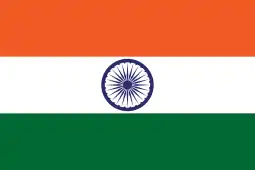
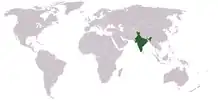
India, officially the Republic of India (ISO: Bhārat Gaṇarājya), is a country in South Asia. It is the seventh-largest country by area; the most populous country as of June 2023; and from the time of its independence in 1947, the world's most populous democracy. Bounded by the Indian Ocean on the south, the Arabian Sea on the southwest, and the Bay of Bengal on the southeast, it shares land borders with Pakistan to the west; China, Nepal, and Bhutan to the north; and Bangladesh and Myanmar to the east. In the Indian Ocean, India is in the vicinity of Sri Lanka and the Maldives; its Andaman and Nicobar Islands share a maritime border with Thailand, Myanmar, and Indonesia. (Full article...)
 Featured article –
Featured article –
 Image 1
Image 1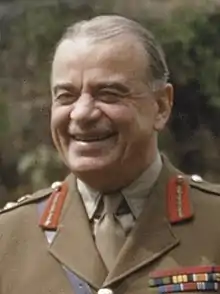 Ismay in 1945
Ismay in 1945
Hastings Lionel Ismay, 1st Baron Ismay KG, GCB, CH, DSO, PC, DL (21 June 1887 – 17 December 1965), was a British politician, diplomat and general in the British Indian Army who was the first Secretary General of NATO. He also was Winston Churchill's chief military assistant during the Second World War.
Ismay was born in Nainital, India, in 1887, and educated in the United Kingdom at Charterhouse School and the Royal Military College, Sandhurst. After Sandhurst, he joined the Indian Army as an officer of the 21st Prince Albert Victor's Own Cavalry. During the First World War, he served with the Camel Corps in British Somaliland, where he joined in the British fight against the "Mad Mullah", Mohammed Abdullah Hassan. In 1925, Ismay became an Assistant Secretary of the Committee of Imperial Defence (CID). After being promoted to the rank of colonel, he served as the military secretary for Lord Willingdon, the Viceroy of India, then returned to the CID as Deputy Secretary in 1936. (Full article...) Image 2Aitraaz (transl. Objection) is a 2004 Indian Hindi-language romantic thriller film directed by Abbas–Mustan and produced by Subhash Ghai. It stars Akshay Kumar, Priyanka Chopra and Kareena Kapoor.
Image 2Aitraaz (transl. Objection) is a 2004 Indian Hindi-language romantic thriller film directed by Abbas–Mustan and produced by Subhash Ghai. It stars Akshay Kumar, Priyanka Chopra and Kareena Kapoor.
Aitraaz tells the story of a man accused of sexual harassment by his female superior, and was released on 12 November 2004 to positive reviews. Chopra received widespread critical acclaim for her performance. Loosely based on the 1994 film Disclosure, the film was a commercial success grossing ₹260 million at the box office against a budget of ₹80 million, and has been noted for its bold subject of sexual harassment. (Full article...)![Image 3Lage Raho Munna Bhai (pronounced [ləˈɡeː rəˈɦoː mʊnːaːˈbʱaːi] ⓘ; transl. Keep going, Munna Bhai) is a 2006 Indian Hindi-language satirical comedy drama film written, edited and directed by Rajkumar Hirani, who co-wrote the screenplay with Abhijat Joshi and produced by Vidhu Vinod Chopra. It is the follow-up to the 2003 film Munna Bhai M.B.B.S. with Sanjay Dutt and Arshad Warsi reprising their roles as Munna Bhai, a Mumbai underworld don, and his sidekick, Circuit, respectively. Vidya Balan portrays the female lead, replacing Gracy Singh from the original, while several other actors from the first film, notably Jimmy Sheirgill and Boman Irani, appear in new roles. In Lage Raho Munna Bhai, the eponymous lead character starts to see the spirit of Mahatma Gandhi. Through his interactions with Gandhi, he begins to practice what he refers to as Gandhigiri (a neologism for Gandhism) to help ordinary people solve their problems.Lage Raho Munna Bhai was released on 1 September 2006, receiving widespread critical acclaim for its direction, story, screenplay, dialogues, performances of the cast, and its social message and themes. The film proved to be a major box-office success, grossing over ₹1.270 billion (equivalent to ₹4.1 billion or US$51 million in 2023) worldwide and became the third highest grossing film of the year. (Full article...)](../I/Blank.png.webp) Image 3Lage Raho Munna Bhai (pronounced [ləˈɡeː rəˈɦoː mʊnːaːˈbʱaːi] ⓘ; transl. Keep going, Munna Bhai) is a 2006 Indian Hindi-language satirical comedy drama film written, edited and directed by Rajkumar Hirani, who co-wrote the screenplay with Abhijat Joshi and produced by Vidhu Vinod Chopra. It is the follow-up to the 2003 film Munna Bhai M.B.B.S. with Sanjay Dutt and Arshad Warsi reprising their roles as Munna Bhai, a Mumbai underworld don, and his sidekick, Circuit, respectively. Vidya Balan portrays the female lead, replacing Gracy Singh from the original, while several other actors from the first film, notably Jimmy Sheirgill and Boman Irani, appear in new roles. In Lage Raho Munna Bhai, the eponymous lead character starts to see the spirit of Mahatma Gandhi. Through his interactions with Gandhi, he begins to practice what he refers to as Gandhigiri (a neologism for Gandhism) to help ordinary people solve their problems.
Image 3Lage Raho Munna Bhai (pronounced [ləˈɡeː rəˈɦoː mʊnːaːˈbʱaːi] ⓘ; transl. Keep going, Munna Bhai) is a 2006 Indian Hindi-language satirical comedy drama film written, edited and directed by Rajkumar Hirani, who co-wrote the screenplay with Abhijat Joshi and produced by Vidhu Vinod Chopra. It is the follow-up to the 2003 film Munna Bhai M.B.B.S. with Sanjay Dutt and Arshad Warsi reprising their roles as Munna Bhai, a Mumbai underworld don, and his sidekick, Circuit, respectively. Vidya Balan portrays the female lead, replacing Gracy Singh from the original, while several other actors from the first film, notably Jimmy Sheirgill and Boman Irani, appear in new roles. In Lage Raho Munna Bhai, the eponymous lead character starts to see the spirit of Mahatma Gandhi. Through his interactions with Gandhi, he begins to practice what he refers to as Gandhigiri (a neologism for Gandhism) to help ordinary people solve their problems.
Lage Raho Munna Bhai was released on 1 September 2006, receiving widespread critical acclaim for its direction, story, screenplay, dialogues, performances of the cast, and its social message and themes. The film proved to be a major box-office success, grossing over ₹1.270 billion (equivalent to ₹4.1 billion or US$51 million in 2023) worldwide and became the third highest grossing film of the year. (Full article...) Image 4Osbert Guy Stanhope Crawford CBE FBA FSA (28 October 1886 – 28 November 1957) was a British archaeologist who specialised in the archaeology of prehistoric Britain and Sudan. A keen proponent of aerial archaeology, he spent most of his career as the archaeological officer of the Ordnance Survey (OS) and also wrote a range of books on archaeological subjects.
Image 4Osbert Guy Stanhope Crawford CBE FBA FSA (28 October 1886 – 28 November 1957) was a British archaeologist who specialised in the archaeology of prehistoric Britain and Sudan. A keen proponent of aerial archaeology, he spent most of his career as the archaeological officer of the Ordnance Survey (OS) and also wrote a range of books on archaeological subjects.
Born in Bombay, British India, to a wealthy middle-class Scottish family, Crawford moved to England as an infant and was raised by his aunts in London and Hampshire. He studied geography at Keble College, Oxford, and worked briefly in that field before devoting himself professionally to archaeology. Employed by the philanthropist Henry Wellcome, Crawford oversaw the excavation of Abu Geili in Sudan before returning to England shortly before the First World War. During the conflict he served in both the London Scottish Regiment and the Royal Flying Corps, where he was involved in ground and aerial reconnaissance along the Western Front. After an injury forced a period of convalescence in England, he returned to the Western Front, where he was captured by the German Army in 1918 and held as a prisoner of war until the end of the conflict. (Full article...) Image 5
Image 5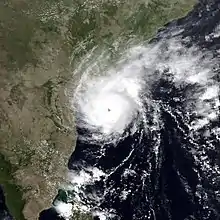 Gay at peak intensity before making landfall on India, on 8 November
Gay at peak intensity before making landfall on India, on 8 November
Typhoon Gay, also known as the Kavali Cyclone of 1989, was a small but powerful tropical cyclone which caused more than 800 fatalities in and around the Gulf of Thailand in November 1989. The worst typhoon to affect the Malay Peninsula in thirty-five years, Gay originated from a monsoon trough over the Gulf of Thailand in early November. Owing to favorable atmospheric conditions, the storm rapidly intensified, attaining winds over 120 km/h (75 mph) by 3 November. Later that day, Gay became the first typhoon since 1891 to make landfall in Thailand, striking Chumphon Province with winds of 185 km/h (115 mph). The small storm emerged into the Bay of Bengal and gradually reorganized over the following days as it approached southeastern India. On 8 November, Gay attained its peak intensity as a Category 5-equivalent cyclone with winds of 260 km/h (160 mph). The cyclone then moved ashore near Kavali, Andhra Pradesh. Rapid weakening ensued inland, and Gay dissipated over Maharashtra early on 10 November.
The typhoon's rapid development took hundreds of vessels by surprise, leading to 275 offshore fatalities. Of these, 91 occurred after an oil drilling ship, the Seacrest, capsized amid 6–11 m (20–36 ft) swells. Across the Malay Peninsula, 588 people died from various storm-related incidents. Several towns in coastal Chumphon were destroyed. Losses throughout Thailand totaled ฿11 billion (US $497 million). Striking India as a powerful cyclone, Gay damaged or destroyed about 20,000 homes in Andhra Pradesh, leaving 100,000 people homeless. In that country, 69 deaths and ₹410 million (US $25.3 million) in damage were attributed to Gay. (Full article...) Image 6
Image 6
In May 2003, a tropical cyclone officially called Very Severe Cyclonic Storm BOB 01 produced the worst flooding in Sri Lanka in 56 years. The first storm of the 2003 North Indian Ocean cyclone season, it developed over the Bay of Bengal on May 10. Favorable environmental conditions allowed the system to intensify steadily while moving northwestward. The storm reached peak maximum sustained winds of 140 km/h (85 mph) on May 13, making it a very severe cyclonic storm according to the India Meteorological Department (IMD), which is the official Regional Specialized Meteorological Center for the basin. The cyclone drifted north over the central Bay of Bengal, gradually weakening due to heightened wind shear. Turning eastward, the storm deteriorated to a deep depression on May 16 before it curved northeastward and re-intensified into a cyclonic storm. It came ashore in western Myanmar and dissipated over land the following day.
In the wake of prolonged precipitation during the first half of May, the cyclone produced torrential rains across southwest Sri Lanka while stationary in the central Bay of Bengal. The storm drew extensive moisture that coalesced in the mountainous portion of the island. A station at Ratnapura recorded 366.1 mm (14.41 in) of rainfall in 18 hours on May 17, including 99.8 mm (3.93 in) in one hour. In southwestern Sri Lanka, the rainfall caused flooding and landslides that destroyed 24,750 homes and damaged 32,426 others, displacing about 800,000 people. Overall damage totaled about $135 million (2003 USD), and there were 260 deaths. The cyclone also produced some rainfall in the Andaman and Nicobar Islands of India and along the country's eastern coast. The storm funneled moisture away from the mainland, which possibly contributed to a heat wave that killed 1,900 people, and dropped heavy rainfall in Myanmar. (Full article...) Image 7The Legend of Bhagat Singh is a 2002 Indian Hindi-language biographical period film directed by Rajkumar Santoshi. The film is about Bhagat Singh, a revolutionary who fought for Indian independence along with fellow members of the Hindustan Socialist Republican Association. It features Ajay Devgan as the titular character along with Sushant Singh, D. Santosh and Akhilendra Mishra as the other lead characters. Raj Babbar, Farida Jalal and Amrita Rao play supporting roles. The film chronicles Singh's life from his childhood where he witnesses the Jallianwala Bagh massacre until the day he was hanged to death before the official trial dated 24 March 1931.
Image 7The Legend of Bhagat Singh is a 2002 Indian Hindi-language biographical period film directed by Rajkumar Santoshi. The film is about Bhagat Singh, a revolutionary who fought for Indian independence along with fellow members of the Hindustan Socialist Republican Association. It features Ajay Devgan as the titular character along with Sushant Singh, D. Santosh and Akhilendra Mishra as the other lead characters. Raj Babbar, Farida Jalal and Amrita Rao play supporting roles. The film chronicles Singh's life from his childhood where he witnesses the Jallianwala Bagh massacre until the day he was hanged to death before the official trial dated 24 March 1931.
The film was produced by Kumar and Ramesh Taurani's Tips Industries on a budget of ₹200–250 million (about US$4.2–5.2 million in 2002). The story and dialogue were written by Santoshi and Piyush Mishra respectively, while Anjum Rajabali drafted the screenplay. K. V. Anand, V. N. Mayekar and Nitin Chandrakant Desai were in charge of the cinematography, editing and production design respectively. Principal photography took place in Agra, Manali, Mumbai and Pune from January to May 2002. The soundtrack and film score is composed by A. R. Rahman, with the songs "Mera Rang De Basanti" and "Sarfaroshi Ki Tamanna" being well received in particular. (Full article...) Image 8
Image 8 Koechlin in 2017
Koechlin in 2017
Kalki Koechlin (/ˈkʌlki kɛˈklæ̃/ ⓘ; born 10 January 1984) is a French actress and writer who works in Hindi films. Known for her unconventional body of work, she is the recipient of such accolades as a National Film Award, a Filmfare Award, and two Screen Awards. Although a French citizen, she has been raised and lived most of her life in India.
Born in Pondicherry, India, Koechlin was drawn to theatre from a young age. She studied drama at Goldsmiths, University of London, and worked simultaneously with a local theatre company. After returning to India, she made her lead screen debut as Chanda in the drama Dev.D in 2009, and won the Filmfare Award for Best Supporting Actress. Subsequently, she starred in two of the highest-grossing Hindi films of their respective release years—the romantic comedy-dramas Zindagi Na Milegi Dobara (2011) and Yeh Jawaani Hai Deewani (2013), both of which garnered her nominations for the Filmfare Award for Best Supporting Actress. Koechlin expanded her career into screenwriting with the 2011 crime thriller That Girl in Yellow Boots, in which she also played the lead role. (Full article...) Image 9Gemini is a 2002 Indian Tamil-language crime action film written and directed by Saran and produced by AVM Productions. The film stars Vikram in the title role of a small-time criminal and aspiring don who, after falling in love, decides to refrain from crime; Kiran Rathod plays his love interest. Murali stars as Singaperumal, a police officer who inspires and guides Gemini in his attempts to reform. The cast includes Kalabhavan Mani as the antagonist while Vinu Chakravarthy, Manorama and Thennavan portray significant roles. Based on gang wars in Chennai, the film delves into the lives of outlaws and the roles the police and society play in their rehabilitation and acceptance.
Image 9Gemini is a 2002 Indian Tamil-language crime action film written and directed by Saran and produced by AVM Productions. The film stars Vikram in the title role of a small-time criminal and aspiring don who, after falling in love, decides to refrain from crime; Kiran Rathod plays his love interest. Murali stars as Singaperumal, a police officer who inspires and guides Gemini in his attempts to reform. The cast includes Kalabhavan Mani as the antagonist while Vinu Chakravarthy, Manorama and Thennavan portray significant roles. Based on gang wars in Chennai, the film delves into the lives of outlaws and the roles the police and society play in their rehabilitation and acceptance.
In early 2001, rival gangsters "Vellai" Ravi and Chera reformed themselves with the patronage of a police officer. Saran was inspired by this incident and scripted a story based on it. Production began shortly afterwards in December the same year and was completed by March 2002. The film was shot mainly at the AVM Studios in Chennai, while two song sequences were filmed in Switzerland. The film had cinematography by A. Venkatesh and editing by Suresh Urs while the soundtrack was scored by Bharadwaj. (Full article...) Image 10Taare Zameen Par (lit. 'Stars on Earth'), also known as Like Stars on Earth in English, is a 2007 Indian Hindi-language drama film produced and directed by Aamir Khan. It stars Khan himself, with Darsheel Safary, Tanay Chheda, Vipin Sharma and Tisca Chopra. It explores the life and imagination of Ishaan (Safary), an artistically gifted 9-year-old boy whose poor academic performance leads his parents to send him to a boarding school, where a new art teacher Nikumbh (Khan) suspects that he is dyslexic and helps him to overcome his reading disorder.
Image 10Taare Zameen Par (lit. 'Stars on Earth'), also known as Like Stars on Earth in English, is a 2007 Indian Hindi-language drama film produced and directed by Aamir Khan. It stars Khan himself, with Darsheel Safary, Tanay Chheda, Vipin Sharma and Tisca Chopra. It explores the life and imagination of Ishaan (Safary), an artistically gifted 9-year-old boy whose poor academic performance leads his parents to send him to a boarding school, where a new art teacher Nikumbh (Khan) suspects that he is dyslexic and helps him to overcome his reading disorder.
Creative director and writer Amole Gupte developed the idea with his wife Deepa Bhatia, who was the film's editor. Shankar–Ehsaan–Loy composed the score, and Prasoon Joshi wrote the lyrics for many of the songs. Principal photography took place in Mumbai, and in Panchgani's New Era High School, where some of the school's students participated in the filming. (Full article...) Image 11Anbe Sivam (transl. Love Is God) is a 2003 Indian Tamil-language comedy drama film directed by Sundar C. and produced by K. Muralitharan, V. Swaminathan and G. Venugopal under the banner of Lakshmi Movie Makers. The film was written by Kamal Haasan, and Madhan provided the dialogues. Anbe Sivam stars Haasan, Madhavan and Kiran Rathod, with Nassar, Santhana Bharathi, Seema and Uma Riyaz Khan playing supporting characters. The film tells the story of Nallasivam and Anbarasu, two men of contrasting personalities who undertake an unexpected journey from Bhubaneswar to Chennai.
Image 11Anbe Sivam (transl. Love Is God) is a 2003 Indian Tamil-language comedy drama film directed by Sundar C. and produced by K. Muralitharan, V. Swaminathan and G. Venugopal under the banner of Lakshmi Movie Makers. The film was written by Kamal Haasan, and Madhan provided the dialogues. Anbe Sivam stars Haasan, Madhavan and Kiran Rathod, with Nassar, Santhana Bharathi, Seema and Uma Riyaz Khan playing supporting characters. The film tells the story of Nallasivam and Anbarasu, two men of contrasting personalities who undertake an unexpected journey from Bhubaneswar to Chennai.
Produced on a budget of ₹120 million, Anbe Sivam takes on themes such as communism, atheism, and altruism and depicts Haasan's humanist views. The music was composed by Vidyasagar. Arthur A. Wilson served as the cinematographer and M. Prabhaharan served as the art director. (Full article...) Image 12The political history of medieval Karnataka spans the 4th to the 16th centuries, when the empires that evolved in the Karnataka region of India made a lasting impact on the subcontinent. Before this, alien empires held sway over the region, and the nucleus of power was outside modern Karnataka. The medieval era can be broadly divided into several periods: The earliest native kingdoms and imperialism; the successful domination of the Gangetic plains in northern India and rivalry with the empires of Tamilakam over the Vengi region; and the domination of the southern Deccan and consolidation against Muslim invasion. The origins of the rise of the Karnataka region as an independent power date back to the fourth-century birth of the Kadamba Dynasty of Banavasi, the earliest of the native rulers to conduct administration in the native language of Kannada in addition to the official Sanskrit. This is the historical starting point in studying the development of the region as an enduring geopolitical entity and of Kannada as an important regional language.
Image 12The political history of medieval Karnataka spans the 4th to the 16th centuries, when the empires that evolved in the Karnataka region of India made a lasting impact on the subcontinent. Before this, alien empires held sway over the region, and the nucleus of power was outside modern Karnataka. The medieval era can be broadly divided into several periods: The earliest native kingdoms and imperialism; the successful domination of the Gangetic plains in northern India and rivalry with the empires of Tamilakam over the Vengi region; and the domination of the southern Deccan and consolidation against Muslim invasion. The origins of the rise of the Karnataka region as an independent power date back to the fourth-century birth of the Kadamba Dynasty of Banavasi, the earliest of the native rulers to conduct administration in the native language of Kannada in addition to the official Sanskrit. This is the historical starting point in studying the development of the region as an enduring geopolitical entity and of Kannada as an important regional language.
In the southern regions of Karnataka, the Western Gangas of Talakad were contemporaries of the Kadambas. The Kadambas and Gangas were followed by the imperial dynasties of the Badami Chalukya Empire, the Rashtrakuta Empire, the Western Chalukya Empire, the Hoysala Empire and the Vijayanagara Empire, all patronising the ancient Indic religions while showing tolerance to the new cultures arriving from the west of the subcontinent. The Muslim invasion of the Deccan resulted in the breaking away of the feudatory Sultanates in the 14th century. The rule of the Bahamani Sultanate of Bidar and the Bijapur Sultanate from the northern Deccan region caused a mingling of the ancient Hindu traditions with the nascent Islamic culture in the region. The hereditary ruling families and clans ably served the large empires and upheld the local culture and traditions. The fall of the Vijayanagara Empire in 1565 brought about a slow disintegration of Kannada-speaking regions into minor kingdoms that struggled to maintain autonomy in an age dominated by foreigners until unification and independence in 1947. (Full article...) Image 13Mother India is a 1957 Indian epic drama film, directed by Mehboob Khan and starring Nargis, Sunil Dutt, Rajendra Kumar and Raaj Kumar. A remake of Khan's earlier film Aurat (1940), it is the story of a poverty-stricken village woman named Radha (Nargis), who in the absence of her husband, struggles to raise her sons and survive against a cunning money-lender amidst many troubles.
Image 13Mother India is a 1957 Indian epic drama film, directed by Mehboob Khan and starring Nargis, Sunil Dutt, Rajendra Kumar and Raaj Kumar. A remake of Khan's earlier film Aurat (1940), it is the story of a poverty-stricken village woman named Radha (Nargis), who in the absence of her husband, struggles to raise her sons and survive against a cunning money-lender amidst many troubles.
The title of the film was chosen to counter American author Katherine Mayo's 1927 polemical book Mother India, which vilified Indian culture. Mother India metaphorically represents India as a nation in the aftermath of its independence in 1947, and alludes to a strong sense of Indian nationalism and nation-building. Allusions to Hindu mythology are abundant in the film, and its lead character has been seen as a metonymic representation of an Indian woman who reflects high moral values and the concept of what it means to be a mother to society through self-sacrifice. While some authors treat Radha as the symbol of women's empowerment, others see her cast in female stereotypes. The film was shot in Mumbai's Mehboob Studios and in the villages of Maharashtra, Gujarat, and Uttar Pradesh. The music by Naushad introduced global music, including Western classical music and orchestra, to Hindi cinema. (Full article...)![Image 14Kapoor in 2017Sonam Kapoor Ahuja (pronounced [soːnəm kəˈpuːr]; born 9 June 1985) is an Indian actress who works in Hindi films. She has received several awards, including a National Film Award and a Filmfare Award, and from 2012 to 2016, she appeared in Forbes India's Celebrity 100 list based on her income and popularity.Kapoor, the daughter of actor Anil Kapoor, began her career as an assistant director on filmmaker Sanjay Leela Bhansali's 2005 film Black. She made her acting debut in Bhansali's romantic drama Saawariya (2007), a box office flop, and had her first commercial success with the romantic comedy I Hate Luv Storys (2010). This was followed by a series of commercial failures and repetitive roles, which garnered her negative reviews. The 2013 box office hit Raanjhanaa marked a turning point in Kapoor's career, garnering her praise and Best Actress nominations at several award ceremonies. (Full article...)](../I/Blank.png.webp) Image 14
Image 14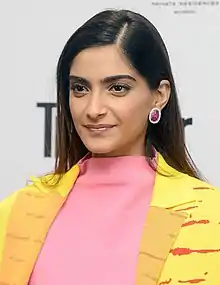 Kapoor in 2017
Kapoor in 2017
Sonam Kapoor Ahuja (pronounced [soːnəm kəˈpuːr]; born 9 June 1985) is an Indian actress who works in Hindi films. She has received several awards, including a National Film Award and a Filmfare Award, and from 2012 to 2016, she appeared in Forbes India's Celebrity 100 list based on her income and popularity.
Kapoor, the daughter of actor Anil Kapoor, began her career as an assistant director on filmmaker Sanjay Leela Bhansali's 2005 film Black. She made her acting debut in Bhansali's romantic drama Saawariya (2007), a box office flop, and had her first commercial success with the romantic comedy I Hate Luv Storys (2010). This was followed by a series of commercial failures and repetitive roles, which garnered her negative reviews. The 2013 box office hit Raanjhanaa marked a turning point in Kapoor's career, garnering her praise and Best Actress nominations at several award ceremonies. (Full article...)![Image 15Sholay (Hindustani: [ˈʃoːleː] ⓘ, transl. Embers) is a 1975 Indian Hindi-language action-adventure film directed by Ramesh Sippy, produced by his father G. P. Sippy, and written by Salim–Javed. The film is about two criminals, Veeru (Dharmendra) and Jai (Amitabh Bachchan), hired by a retired police officer (Sanjeev Kumar) to capture the ruthless dacoit Gabbar Singh (Amjad Khan). Hema Malini and Jaya Bhaduri also star, as Veeru and Jai's love interests, Basanti and Radha, respectively. The music was composed by R D Burman.The film was shot in the rocky terrain of Ramanagara, in the southern state of Karnataka, over a span of two and a half years. After the Central Board of Film Certification mandated the removal of several violent scenes, Sholay was released with a length of 198 minutes. In 1990, the original director's cut of 204 minutes became available on home media. When first released, Sholay received negative critical reviews and a tepid commercial response, but favourable word-of-mouth publicity helped it to become a box office success. It broke records for continuous showings in many theatres across India, and ran for more than five years at Mumbai's Minerva theatre. The film was also an overseas success in the Soviet Union. It was the highest-grossing Indian film ever at the time, and was the highest-grossing film in India up until Hum Aapke Hain Koun..! (1994). By numerous accounts, Sholay remains one of the highest-grossing Indian films of all time, adjusted for inflation. (Full article...)](../I/Blank.png.webp) Image 15Sholay (Hindustani: [ˈʃoːleː] ⓘ, transl. Embers) is a 1975 Indian Hindi-language action-adventure film directed by Ramesh Sippy, produced by his father G. P. Sippy, and written by Salim–Javed. The film is about two criminals, Veeru (Dharmendra) and Jai (Amitabh Bachchan), hired by a retired police officer (Sanjeev Kumar) to capture the ruthless dacoit Gabbar Singh (Amjad Khan). Hema Malini and Jaya Bhaduri also star, as Veeru and Jai's love interests, Basanti and Radha, respectively. The music was composed by R D Burman.
Image 15Sholay (Hindustani: [ˈʃoːleː] ⓘ, transl. Embers) is a 1975 Indian Hindi-language action-adventure film directed by Ramesh Sippy, produced by his father G. P. Sippy, and written by Salim–Javed. The film is about two criminals, Veeru (Dharmendra) and Jai (Amitabh Bachchan), hired by a retired police officer (Sanjeev Kumar) to capture the ruthless dacoit Gabbar Singh (Amjad Khan). Hema Malini and Jaya Bhaduri also star, as Veeru and Jai's love interests, Basanti and Radha, respectively. The music was composed by R D Burman.
The film was shot in the rocky terrain of Ramanagara, in the southern state of Karnataka, over a span of two and a half years. After the Central Board of Film Certification mandated the removal of several violent scenes, Sholay was released with a length of 198 minutes. In 1990, the original director's cut of 204 minutes became available on home media. When first released, Sholay received negative critical reviews and a tepid commercial response, but favourable word-of-mouth publicity helped it to become a box office success. It broke records for continuous showings in many theatres across India, and ran for more than five years at Mumbai's Minerva theatre. The film was also an overseas success in the Soviet Union. It was the highest-grossing Indian film ever at the time, and was the highest-grossing film in India up until Hum Aapke Hain Koun..! (1994). By numerous accounts, Sholay remains one of the highest-grossing Indian films of all time, adjusted for inflation. (Full article...)![Image 16Kal Ho Naa Ho (transl. There may be no tomorrow, pronounced [kəl ɦoː naː ɦoː]), also abbreviated as KHNH, is a 2003 Indian Hindi-language romantic drama film directed by Nikhil Advani in his directoral debut with a story written by Karan Johar with dialogue by Niranjan Iyengar, and produced by Yash Johar. The film stars Jaya Bachchan, Shah Rukh Khan, Saif Ali Khan, and Preity Zinta, with Sushma Seth, Reema Lagoo, Lillete Dubey, and Delnaaz Irani in supporting roles. In the film, Naina Catherine Kapur (Zinta) and Aman Mathur (Shah Rukh Khan) fall in love, but a secret prevents him from reciprocating his feelings and results in a plan to set Naina up with her best friend, Rohit Patel (Saif Ali Khan).Collaborating with Johar, Shankar–Ehsaan–Loy composed the soundtrack and score. Anil Mehta, Manish Malhotra, and Sharmishta Roy were the cinematographer, costume designer and art director, respectively. Principal photography took place in Toronto, New York City, and Mumbai from January to October 2003. The soundtrack was released on 27 September 2003 to positive reviews; the title song, "It's The Time To Disco", "Kuch To Hua Hai", and "Pretty Woman" were particularly well-received. (Full article...)](../I/Blank.png.webp) Image 16Kal Ho Naa Ho (transl. There may be no tomorrow, pronounced [kəl ɦoː naː ɦoː]), also abbreviated as KHNH, is a 2003 Indian Hindi-language romantic drama film directed by Nikhil Advani in his directoral debut with a story written by Karan Johar with dialogue by Niranjan Iyengar, and produced by Yash Johar. The film stars Jaya Bachchan, Shah Rukh Khan, Saif Ali Khan, and Preity Zinta, with Sushma Seth, Reema Lagoo, Lillete Dubey, and Delnaaz Irani in supporting roles. In the film, Naina Catherine Kapur (Zinta) and Aman Mathur (Shah Rukh Khan) fall in love, but a secret prevents him from reciprocating his feelings and results in a plan to set Naina up with her best friend, Rohit Patel (Saif Ali Khan).
Image 16Kal Ho Naa Ho (transl. There may be no tomorrow, pronounced [kəl ɦoː naː ɦoː]), also abbreviated as KHNH, is a 2003 Indian Hindi-language romantic drama film directed by Nikhil Advani in his directoral debut with a story written by Karan Johar with dialogue by Niranjan Iyengar, and produced by Yash Johar. The film stars Jaya Bachchan, Shah Rukh Khan, Saif Ali Khan, and Preity Zinta, with Sushma Seth, Reema Lagoo, Lillete Dubey, and Delnaaz Irani in supporting roles. In the film, Naina Catherine Kapur (Zinta) and Aman Mathur (Shah Rukh Khan) fall in love, but a secret prevents him from reciprocating his feelings and results in a plan to set Naina up with her best friend, Rohit Patel (Saif Ali Khan).
Collaborating with Johar, Shankar–Ehsaan–Loy composed the soundtrack and score. Anil Mehta, Manish Malhotra, and Sharmishta Roy were the cinematographer, costume designer and art director, respectively. Principal photography took place in Toronto, New York City, and Mumbai from January to October 2003. The soundtrack was released on 27 September 2003 to positive reviews; the title song, "It's The Time To Disco", "Kuch To Hua Hai", and "Pretty Woman" were particularly well-received. (Full article...) Image 17
Image 17 Male in Okonjima, Namibia
Male in Okonjima, Namibia
The lion (Panthera leo) is a large cat of the genus Panthera native to Africa and India. It has a muscular, broad-chested body; short, rounded head; round ears; and a hairy tuft at the end of its tail. It is sexually dimorphic; adult male lions are larger than females and have a prominent mane. It is a social species, forming groups called prides. A lion's pride consists of a few adult males, related females, and cubs. Groups of female lions usually hunt together, preying mostly on large ungulates. The lion is an apex and keystone predator; although some lions scavenge when opportunities occur and have been known to hunt humans, lions typically do not actively seek out and prey on humans.
The lion inhabits grasslands, savannahs and shrublands. It is usually more diurnal than other wild cats, but when persecuted, it adapts to being active at night and at twilight. During the Neolithic period, the lion ranged throughout Africa and Eurasia from Southeast Europe to India, but it has been reduced to fragmented populations in sub-Saharan Africa and one population in western India. It has been listed as Vulnerable on the IUCN Red List since 1996 because populations in African countries have declined by about 43% since the early 1990s. Lion populations are untenable outside designated protected areas. Although the cause of the decline is not fully understood, habitat loss and conflicts with humans are the greatest causes for concern. (Full article...)![Image 18Zinta in 2018Preity G Zinta (pronounced [ˈpriːt̪i ˈzɪɳʈa]; born 31 January 1975) is an Indian entrepreneur and former actress primarily known for her work in Hindi films. After graduating with degrees in English honours and criminal psychology, Zinta made her acting debut in Dil Se.. in 1998, followed by a role in Soldier in the same year. These performances earned her the Filmfare Award for Best Female Debut, and she was later recognised for her role as a teenage single mother in Kya Kehna (2000). She subsequently established a career as a leading actress of Hindi cinema with a variety of character types. Her roles, often deemed culturally defiant, along with her unconventional screen persona have been credited with contributing to a change in the concept of Indian film heroines, and won her several accolades.Following critically appreciated roles in Chori Chori Chupke Chupke (2001), Dil Chahta Hai (2001), Dil Hai Tumhaara (2002), and Armaan (2003), Zinta received the Filmfare Award for Best Actress for her performance in Kal Ho Naa Ho (2003). She starred in two consecutive annual top-grossing films in India, Koi... Mil Gaya (2003) and Veer-Zaara (2004), and was noted for her portrayal of independent, modern Indian women in Salaam Namaste (2005) and Kabhi Alvida Naa Kehna (2006), top-grossing productions in domestic and overseas markets. For her first international role in the Canadian drama Heaven on Earth (2008) she was awarded the Silver Hugo Award for Best Actress and nominated for the Genie Award for Best Actress. She followed this with a hiatus from acting work for several years, with the exception of her self-produced comeback film, Ishkq in Paris (2013), which failed to leave a mark. (Full article...)](../I/Blank.png.webp) Image 18
Image 18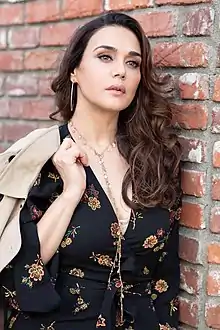 Zinta in 2018
Zinta in 2018
Preity G Zinta (pronounced [ˈpriːt̪i ˈzɪɳʈa]; born 31 January 1975) is an Indian entrepreneur and former actress primarily known for her work in Hindi films. After graduating with degrees in English honours and criminal psychology, Zinta made her acting debut in Dil Se.. in 1998, followed by a role in Soldier in the same year. These performances earned her the Filmfare Award for Best Female Debut, and she was later recognised for her role as a teenage single mother in Kya Kehna (2000). She subsequently established a career as a leading actress of Hindi cinema with a variety of character types. Her roles, often deemed culturally defiant, along with her unconventional screen persona have been credited with contributing to a change in the concept of Indian film heroines, and won her several accolades.
Following critically appreciated roles in Chori Chori Chupke Chupke (2001), Dil Chahta Hai (2001), Dil Hai Tumhaara (2002), and Armaan (2003), Zinta received the Filmfare Award for Best Actress for her performance in Kal Ho Naa Ho (2003). She starred in two consecutive annual top-grossing films in India, Koi... Mil Gaya (2003) and Veer-Zaara (2004), and was noted for her portrayal of independent, modern Indian women in Salaam Namaste (2005) and Kabhi Alvida Naa Kehna (2006), top-grossing productions in domestic and overseas markets. For her first international role in the Canadian drama Heaven on Earth (2008) she was awarded the Silver Hugo Award for Best Actress and nominated for the Genie Award for Best Actress. She followed this with a hiatus from acting work for several years, with the exception of her self-produced comeback film, Ishkq in Paris (2013), which failed to leave a mark. (Full article...) Image 19
Image 19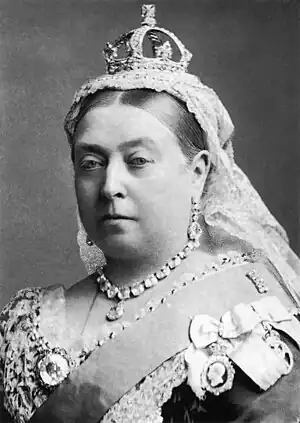 Portrait by Alexander Bassano, 1882
Portrait by Alexander Bassano, 1882
Victoria (Alexandrina Victoria; 24 May 1819 – 22 January 1901) was Queen of the United Kingdom of Great Britain and Ireland from 20 June 1837 until her death in 1901. Her reign of 63 years and 216 days, which was longer than any of her predecessors, is known as the Victorian era. It was a period of industrial, political, scientific, and military change within the United Kingdom, and was marked by a great expansion of the British Empire. In 1876, the British Parliament voted to grant her the additional title of Empress of India.
Victoria was the daughter of Prince Edward, Duke of Kent and Strathearn (the fourth son of King George III), and Princess Victoria of Saxe-Coburg-Saalfeld. After the deaths of her father and grandfather in 1820, she was raised under close supervision by her mother and her comptroller, John Conroy. She inherited the throne aged 18 after her father's three elder brothers died without surviving legitimate issue. Victoria, a constitutional monarch, attempted privately to influence government policy and ministerial appointments; publicly, she became a national icon who was identified with strict standards of personal morality. (Full article...) Image 20
Image 20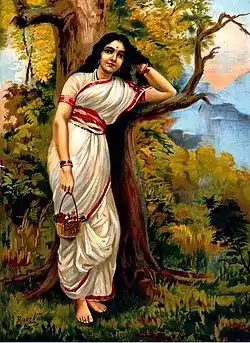 Ahalya by Raja Ravi Varma (1848–1906)
Ahalya by Raja Ravi Varma (1848–1906)
In Hinduism, Ahalya (Sanskrit: अहल्या, IAST: Ahalyā) also known as Ahilya, is the wife of the sage Gautama Maharishi. Many Hindu scriptures describe her legend of seduction by Indra, her husband's curse for her infidelity, and her liberation from the curse by Rama.
Created by the god Brahma as the most beautiful woman, Ahalya was married to the much older Gautama. In the earliest full narrative, when Indra comes disguised as her husband, Ahalya sees through his disguise but nevertheless accepts his advances. Later sources often absolve her of all guilt, describing how she falls prey to Indra's trickery. In all narratives, Ahalya and Indra are cursed by Gautama. The curse varies from text to text, but almost all versions describe Rama as the eventual agent of her liberation and redemption. Although early texts describe how Ahalya must atone by undergoing severe penance while remaining invisible to the world and how she is purified by offering Rama hospitality, in the popular retelling developed over time, Ahalya is cursed to become a stone and regains her human form after she is brushed by Rama's foot. (Full article...)![Image 21Padukone at the 2018 Cannes Film FestivalDeepika Padukone (pronounced [d̪iːpɪka pəɖʊkoːɳeː] or [paːɖʊkoːɳ]; born 5 January 1986) is an Indian actress who works predominantly in Hindi films. One of the highest-paid actresses in India, her accolades include three Filmfare Awards. She features in listings of the nation's most popular personalities; Time named her one of the 100 most influential people in the world in 2018 and awarded her the Time100 Impact Award in 2022.Padukone, the daughter of the badminton player Prakash Padukone, was born in Copenhagen and raised in Bangalore. As a teenager, she played badminton in national level championships but left her career in the sport to become a fashion model. She soon received offers for film roles and made her acting debut in 2006 as the title character of the Kannada film Aishwarya. Padukone then played a dual role opposite Shah Rukh Khan in her first Bollywood release, the romance Om Shanti Om (2007), which won her the Filmfare Award for Best Female Debut. Padukone received praise for her starring role in the romance Love Aaj Kal (2009), but this was followed by a brief setback. (Full article...)](../I/Blank.png.webp) Image 21
Image 21.jpg.webp) Padukone at the 2018 Cannes Film Festival
Padukone at the 2018 Cannes Film Festival
Deepika Padukone (pronounced [d̪iːpɪka pəɖʊkoːɳeː] or [paːɖʊkoːɳ]; born 5 January 1986) is an Indian actress who works predominantly in Hindi films. One of the highest-paid actresses in India, her accolades include three Filmfare Awards. She features in listings of the nation's most popular personalities; Time named her one of the 100 most influential people in the world in 2018 and awarded her the Time100 Impact Award in 2022.
Padukone, the daughter of the badminton player Prakash Padukone, was born in Copenhagen and raised in Bangalore. As a teenager, she played badminton in national level championships but left her career in the sport to become a fashion model. She soon received offers for film roles and made her acting debut in 2006 as the title character of the Kannada film Aishwarya. Padukone then played a dual role opposite Shah Rukh Khan in her first Bollywood release, the romance Om Shanti Om (2007), which won her the Filmfare Award for Best Female Debut. Padukone received praise for her starring role in the romance Love Aaj Kal (2009), but this was followed by a brief setback. (Full article...) Image 22The Bengali language movement (Bengali: ভাষা আন্দোলন, romanized: Bhasha Andolôn) was a political movement in former East Bengal (renamed East Pakistan in 1955) advocating the recognition of the Bengali language as an official language of the then-Dominion of Pakistan to allow its use in government affairs, the continuation of its use as a medium of education, its use in media, currency and stamps, and to maintain its writing in the Bengali script.
Image 22The Bengali language movement (Bengali: ভাষা আন্দোলন, romanized: Bhasha Andolôn) was a political movement in former East Bengal (renamed East Pakistan in 1955) advocating the recognition of the Bengali language as an official language of the then-Dominion of Pakistan to allow its use in government affairs, the continuation of its use as a medium of education, its use in media, currency and stamps, and to maintain its writing in the Bengali script.
When the Dominion of Pakistan was formed after the separation of the Indian subcontinent in 1947 when the British left, it was composed of various ethnic and linguistic groups, with the geographically non-contiguous East Bengal province having a mainly ethnic Bengali population. In 1948, the Government of the Dominion of Pakistan ordained as part of Islamization and Arabization of East Pakistan or East Bengal that Urdu will be the sole national language, alternately Bengali writing in Arabic script or Roman script (Romanisation of Bengali) or Arabic as the state language of the whole of Pakistan was also proposed, sparking extensive protests among the Bengali-speaking majority of East Bengal. Facing rising sectarian tensions and mass discontent with the new law, the government outlawed public meetings and rallies. The students of the University of Dhaka and other political activists defied the law and organised a protest on 21 February 1952. The movement reached its climax when police killed student demonstrators on that day. The deaths provoked widespread civil unrest. After years of conflict, the central government relented and granted official status to the Bengali language in 1956. (Full article...) Image 23
Image 23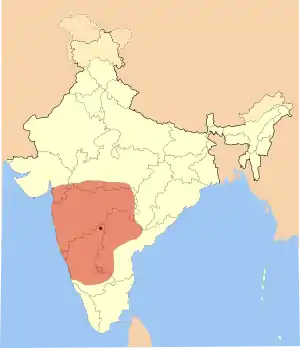 Territory of the Western Chalukyas (c. 1100 CE) in India (modern boundaries shown) and the empire's capital, Kalyani, in the modern Bidar district, Karnataka state, India
Territory of the Western Chalukyas (c. 1100 CE) in India (modern boundaries shown) and the empire's capital, Kalyani, in the modern Bidar district, Karnataka state, India
A large body of Western Chalukya literature in the Kannada language was produced during the reign of the Western Chalukya Empire (973–1200 CE) in what is now southern India. This dynasty, which ruled most of the western Deccan in South India, is sometimes called the Kalyani Chalukya Dynasty after its royal capital at Kalyani (now Basavakalyan), and sometimes called the Later Chalukya Dynasty for its theoretical relationship to the 6th-century Chalukya dynasty of Badami. For a brief period (1162–1183), the Kalachuris of Kalyani, a dynasty of kings who had earlier migrated to the Karnataka region from central India and served as vassals for several generations, exploited the growing weakness of their overlords and annexed the Kalyani. Around 1183, the last Chalukya scion, Someshvara IV, overthrew the Kalachuris to regain control of the royal city. But his efforts were in vain, as other prominent Chalukya vassals in the Deccan, the Hoysalas, the Kakatiyas and the Seunas destroyed the remnants of the Chalukya power.
Kannada literature from this period is usually categorised into the linguistic phase called Old-Kannada. It constituted the bulk of the Chalukya court's textual production and pertained mostly to writings relating to the socio-religious development of the Jain faith. The earliest well-known writers belonging to the Shaiva faith are also from this period. Under the patronage of Kalachuri King Bijjala II, whose prime minister was the well-known Kannada poet and social reformer Basavanna, a native form of poetic literature called Vachana literature (lit "utterance", "saying" or "sentence") proliferated. The beginnings of the Vachana poetic tradition in the Kannada-speaking region trace back to the early 11th century. Kannada literature written in the champu metre, composed of prose and verse, was popularised by the Chalukyan court poets. However, with the advent of the Veerashaiva (lit, "brave devotees of the god Shiva") religious movement in the mid-12th century, poets favoured the native tripadi (three-line verse composed of eleven ganas or prosodic units), hadugabba (song-poem) and free verse metres for their poems. (Full article...) Image 24Loev (pronounced love) is a 2015 Indian romantic drama film written and directed by Sudhanshu Saria. It stars Dhruv Ganesh and Shiv Panditt as two friends who set off to the Western Ghats for a weekend trip and focuses on their complex emotional and sexual relationship. It was Ganesh's final film, as he died from tuberculosis before its release. Loev also features Siddharth Menon and Rishabh Chaddha in supporting roles. The film's title is a deliberate misspelling of the word "love".
Image 24Loev (pronounced love) is a 2015 Indian romantic drama film written and directed by Sudhanshu Saria. It stars Dhruv Ganesh and Shiv Panditt as two friends who set off to the Western Ghats for a weekend trip and focuses on their complex emotional and sexual relationship. It was Ganesh's final film, as he died from tuberculosis before its release. Loev also features Siddharth Menon and Rishabh Chaddha in supporting roles. The film's title is a deliberate misspelling of the word "love".
Saria wrote Loev's script while he was working on the draft of the unreleased film I Am Here and drew heavily from his personal experiences. It was eventually picked up for production by Arfi Lamba and Katherine Suckale despite Saria's own doubts on its viability. Principal photography took place at Mahabaleshwar, in the Western Ghats in peninsular India, and at Mumbai. The film was shot in the summer of 2014 over the course of sixteen days by the cinematographer Sherri Kauk in 2K resolution. It relied on crowdfunding and cost-cutting measures; its budget was relatively low at US$1 million. (Full article...) Image 25
Image 25 Core Western Ganga Territory
Core Western Ganga Territory
Western Ganga was an important ruling dynasty of ancient Karnataka in India which lasted from about 350 to 1000 CE. They are known as "Western Gangas" to distinguish them from the Eastern Gangas who in later centuries ruled over Kalinga (modern Odisha and Northern Andhra Pradesh). The general belief is that the Western Gangas began their rule during a time when multiple native clans asserted their freedom due to the weakening of the Pallava empire in South India, a geo-political event sometimes attributed to the southern conquests of Samudra Gupta. The Western Ganga sovereignty lasted from about 350 to 550 CE, initially ruling from Kolar and later, moving their capital to Talakadu on the banks of the Kaveri River in modern Mysore district.
After the rise of the imperial Chalukyas of Badami, the Gangas accepted Chalukya overlordship and fought for the cause of their overlords against the Pallavas of Kanchi. The Chalukyas were replaced by the Rashtrakutas of Manyakheta in 753 CE as the dominant power in the Deccan. After a century of struggle for autonomy, the Western Gangas finally accepted Rashtrakuta overlordship and successfully fought alongside them against their foes, the Chola Dynasty of Tanjavur. In the late 10th century, north of Tungabhadra river, the Rashtrakutas were replaced by the emerging Western Chalukya Empire and the Chola Dynasty saw renewed power south of the Kaveri river. The defeat of the Western Gangas by Cholas around 1000 resulted in the end of the Ganga influence over the region. (Full article...)
Selected pictures
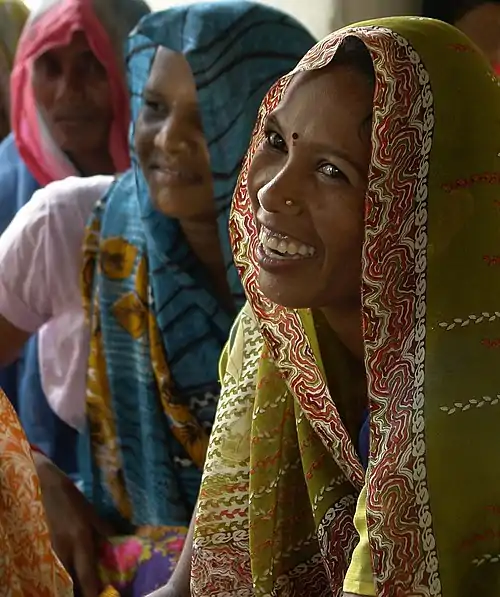 Image 1Photo: YannWomen of the Gondi, the largest tribe of Indian aboriginals in central India. They are classified as a scheduled tribe in most Indian states. The Gondi language is related to Telugu and other Dravidian languages. About half of Gonds speak Gondi languages, while the rest speak Indo-Aryan languages including Hindi. For many years during the British colonial period, the Gonds were considered to have performed human sacrifices, although this notion was later discredited.
Image 1Photo: YannWomen of the Gondi, the largest tribe of Indian aboriginals in central India. They are classified as a scheduled tribe in most Indian states. The Gondi language is related to Telugu and other Dravidian languages. About half of Gonds speak Gondi languages, while the rest speak Indo-Aryan languages including Hindi. For many years during the British colonial period, the Gonds were considered to have performed human sacrifices, although this notion was later discredited. Image 2Photograph: JkadavoorCupha erymanthis is a species of brush-footed butterfly found in forested areas of tropical South and Southeast Asia which may feed on liquids from carrion. This specimen was photographed in Kadavoor, Kerala, India.
Image 2Photograph: JkadavoorCupha erymanthis is a species of brush-footed butterfly found in forested areas of tropical South and Southeast Asia which may feed on liquids from carrion. This specimen was photographed in Kadavoor, Kerala, India.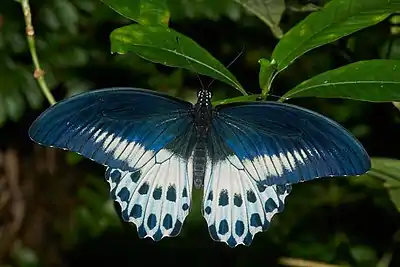 Image 3Photograph credit: Jeevan JosePapilio polymnestor, the blue Mormon, is a species of swallowtail butterfly found in southern India and Sri Lanka. It is a woodland species, often seen on forest paths and near streams. The larvae feed on trees in the family Rutaceae, such as citrus. Young larvae are green with white markings and position themselves on the upper surface of leaves, relying on their cryptic colouring, which resembles bird droppings, for protection. Older larvae seek less conspicuous locations, and have a unique habit of securing their balance by weaving silk on the substratum. This adult male P. polymnestor butterfly was photographed in the Indian state of Kerala.
Image 3Photograph credit: Jeevan JosePapilio polymnestor, the blue Mormon, is a species of swallowtail butterfly found in southern India and Sri Lanka. It is a woodland species, often seen on forest paths and near streams. The larvae feed on trees in the family Rutaceae, such as citrus. Young larvae are green with white markings and position themselves on the upper surface of leaves, relying on their cryptic colouring, which resembles bird droppings, for protection. Older larvae seek less conspicuous locations, and have a unique habit of securing their balance by weaving silk on the substratum. This adult male P. polymnestor butterfly was photographed in the Indian state of Kerala.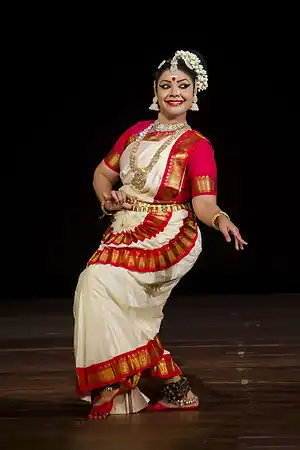 Image 4Photo: Augustus BinuRekha Raju performing Mohiniyattam, a classical dance form from Kerala, India. Believed to have originated in the 16th century CE, this dance form was popularized in the nineteenth century by Swathi Thirunal, the Maharaja of the state of Travancore, and Vadivelu, one of the Thanjavur Quartet. The dance, which has about 40 different movements, involves the swaying of broad hips and the gentle side-to-side movements.
Image 4Photo: Augustus BinuRekha Raju performing Mohiniyattam, a classical dance form from Kerala, India. Believed to have originated in the 16th century CE, this dance form was popularized in the nineteenth century by Swathi Thirunal, the Maharaja of the state of Travancore, and Vadivelu, one of the Thanjavur Quartet. The dance, which has about 40 different movements, involves the swaying of broad hips and the gentle side-to-side movements._male_underside.jpg.webp) Image 5Photograph credit: Charles James SharpDanaus genutia, the common tiger or striped tiger, is a species of brush-footed butterfly found in Sri Lanka, India, Myanmar, south-eastern Asia and Australia. It prefers areas of moderate to heavy rainfall, and typical habitats include scrubby jungle, deciduous forests and fallow land near habitations. The insect sequesters toxins from plants, and advertises its unpalatability by having prominent markings and striking colour patterns. This adult male common tiger, of the subspecies D. g. genutia, was photographed in Kerala, India.
Image 5Photograph credit: Charles James SharpDanaus genutia, the common tiger or striped tiger, is a species of brush-footed butterfly found in Sri Lanka, India, Myanmar, south-eastern Asia and Australia. It prefers areas of moderate to heavy rainfall, and typical habitats include scrubby jungle, deciduous forests and fallow land near habitations. The insect sequesters toxins from plants, and advertises its unpalatability by having prominent markings and striking colour patterns. This adult male common tiger, of the subspecies D. g. genutia, was photographed in Kerala, India.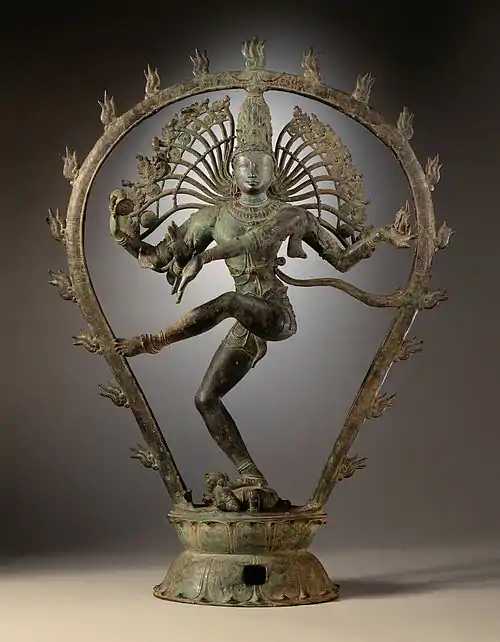 Image 6A statue of the Hindu god Shiva as Nataraja, the Lord of Dance. In this form, Shiva performs his divine dance to destroy a weary universe and make preparations for the god Brahma to start the process of creation. A Telugu and Tamil concept, Shiva was first depicted as Nataraja in the famous Chola bronzes and sculptures of Chidambaram. The form is present in most Shiva temples in South India, and is the main deity in Chidambaram Temple, the foremost Shaivist temple.
Image 6A statue of the Hindu god Shiva as Nataraja, the Lord of Dance. In this form, Shiva performs his divine dance to destroy a weary universe and make preparations for the god Brahma to start the process of creation. A Telugu and Tamil concept, Shiva was first depicted as Nataraja in the famous Chola bronzes and sculptures of Chidambaram. The form is present in most Shiva temples in South India, and is the main deity in Chidambaram Temple, the foremost Shaivist temple..jpg.webp) Image 7Photograph credit: Charles J. SharpThe Indian roller (Coracias benghalensis) is a member of the bird family Coraciidae, the rollers. It occurs widely from the Arabian Peninsula to the Indian subcontinent and is designated as Least Concern on the IUCN Red List. The bird is best known for the aerobatic displays of males during the breeding season. It is commonly found in open grassland and scrub forest habitats, and is often seen perched on roadside bare trees and wires, which give it a good view of the ground below where it finds its prey. Its diet consists mainly of insects such as beetles and grasshoppers, but also includes spiders, scorpions, amphibians and small reptiles. The largest population occurs in India, and several states in India have chosen it as their state bird.
Image 7Photograph credit: Charles J. SharpThe Indian roller (Coracias benghalensis) is a member of the bird family Coraciidae, the rollers. It occurs widely from the Arabian Peninsula to the Indian subcontinent and is designated as Least Concern on the IUCN Red List. The bird is best known for the aerobatic displays of males during the breeding season. It is commonly found in open grassland and scrub forest habitats, and is often seen perched on roadside bare trees and wires, which give it a good view of the ground below where it finds its prey. Its diet consists mainly of insects such as beetles and grasshoppers, but also includes spiders, scorpions, amphibians and small reptiles. The largest population occurs in India, and several states in India have chosen it as their state bird.
This picture shows an Indian roller of the benghalensis subspecies, photographed in Kanha Tiger Reserve in the Indian state of Madhya Pradesh._wb_edit.jpg.webp) Image 8Photograph: Arthur Chapman; edit: Papa Lima Whiskey and Ryan KaldariBrahmaea wallichii, also known as the owl moth, is a moth from the family Brahmaeidae. With a wingspan of about 90–160 mm (3.5–6.3 in), it is one of the largest species of Brahmin moth. This nocturnal species is found in India, Bhutan, Myanmar, China, Taiwan and Japan.
Image 8Photograph: Arthur Chapman; edit: Papa Lima Whiskey and Ryan KaldariBrahmaea wallichii, also known as the owl moth, is a moth from the family Brahmaeidae. With a wingspan of about 90–160 mm (3.5–6.3 in), it is one of the largest species of Brahmin moth. This nocturnal species is found in India, Bhutan, Myanmar, China, Taiwan and Japan.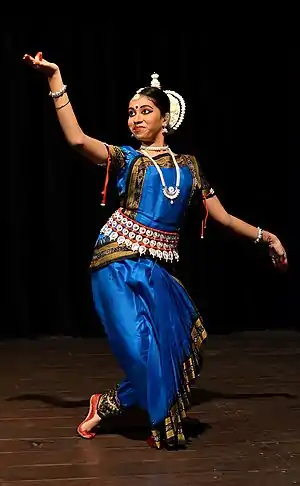 Image 9Photograph: Augustus BinuOdissi is an ancient classical dance that originated in the Hindu temples of Odisha, India. Historically, it has been performed predominantly by women, and expressed religious stories and spiritual ideas, particularly of Vaishnavism (Vishnu as Jagannath), but also of other traditions such as those related to Hindu gods Shiva and Surya, as well as Hindu goddesses (Shaktism). Modern Odissi productions by Indian artists have presented a diverse range of experimental ideas, culture fusion, themes and plays.
Image 9Photograph: Augustus BinuOdissi is an ancient classical dance that originated in the Hindu temples of Odisha, India. Historically, it has been performed predominantly by women, and expressed religious stories and spiritual ideas, particularly of Vaishnavism (Vishnu as Jagannath), but also of other traditions such as those related to Hindu gods Shiva and Surya, as well as Hindu goddesses (Shaktism). Modern Odissi productions by Indian artists have presented a diverse range of experimental ideas, culture fusion, themes and plays.
Odissi is learnt and performed as a composite of a basic dance motif called the Bhangas (symmetric body bends, stance). It involves the lower, mid, and upper body as three sources of perfecting expression and audience engagement with geometric symmetry and rhythmic musical resonance.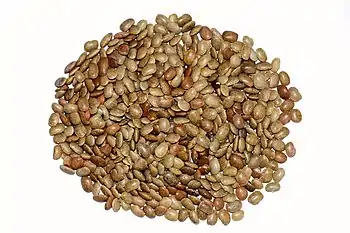 Image 10Photograph credit: Prathyush ThomasMacrotyloma uniflorum, commonly known as horse gram, is a legume native to tropical southern Asia. The plant grows from a rhizome, sending up annual shoots to a height of 60 cm (24 in). The flowers are cream, yellow or pale green and are followed by short pods. The seeds, pictured here, have been consumed in India for at least 4,000 years and are used both for animal feed and human consumption, including Ayurvedic cuisine. In other tropical countries in southeastern Asia, and in northern Australia, the plant is grown mainly as a fodder crop and for use as green manure. It is a drought-tolerant plant, largely cultivated in areas with low rainfall.
Image 10Photograph credit: Prathyush ThomasMacrotyloma uniflorum, commonly known as horse gram, is a legume native to tropical southern Asia. The plant grows from a rhizome, sending up annual shoots to a height of 60 cm (24 in). The flowers are cream, yellow or pale green and are followed by short pods. The seeds, pictured here, have been consumed in India for at least 4,000 years and are used both for animal feed and human consumption, including Ayurvedic cuisine. In other tropical countries in southeastern Asia, and in northern Australia, the plant is grown mainly as a fodder crop and for use as green manure. It is a drought-tolerant plant, largely cultivated in areas with low rainfall._female.jpg.webp) Image 11Photograph credit: Charles James SharpThe pied bush chat (Saxicola caprata) is a small passerine bird widely distributed in Asia. The males are black with white shoulder and vent patches, while the females are predominantly brownish. This species is insectivorous, and like other chats hunts from a prominent low perch. This female pied bush chat was photographed in Pench National Park, India.
Image 11Photograph credit: Charles James SharpThe pied bush chat (Saxicola caprata) is a small passerine bird widely distributed in Asia. The males are black with white shoulder and vent patches, while the females are predominantly brownish. This species is insectivorous, and like other chats hunts from a prominent low perch. This female pied bush chat was photographed in Pench National Park, India.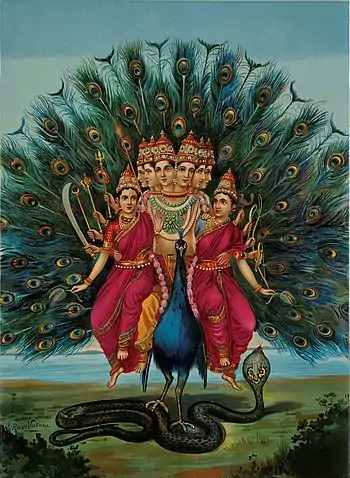 Image 12Painting: Raja Ravi Varma
Image 12Painting: Raja Ravi Varma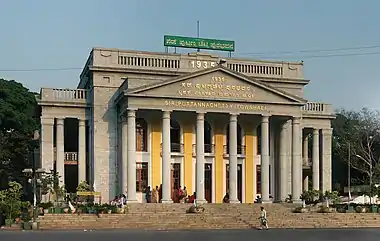 Image 13Photo: Muhammad Mahdi KarimBangalore Town Hall is a neoclassical municipal building in Bangalore, India. It is sometimes known, after a former president of Bangalore, as the Sir K. P. Puttanna Chetty Town Hall. Built by Mirza Ismail in 1935, it underwent renovations in 1990 at a cost of ₹6.5 million (US$371,400 at the time).
Image 13Photo: Muhammad Mahdi KarimBangalore Town Hall is a neoclassical municipal building in Bangalore, India. It is sometimes known, after a former president of Bangalore, as the Sir K. P. Puttanna Chetty Town Hall. Built by Mirza Ismail in 1935, it underwent renovations in 1990 at a cost of ₹6.5 million (US$371,400 at the time). Image 14Photo credit: Dan BradyPigments for sale at a market stall in Goa, India. Many pigments used in manufacturing and the visual arts are dry colourants, ground into a fine powder. This powder is then added to a vehicle or matrix, a relatively neutral or colorless material that acts as a binder, before it is applied. Unlike a dye, a pigment generally is insoluble.
Image 14Photo credit: Dan BradyPigments for sale at a market stall in Goa, India. Many pigments used in manufacturing and the visual arts are dry colourants, ground into a fine powder. This powder is then added to a vehicle or matrix, a relatively neutral or colorless material that acts as a binder, before it is applied. Unlike a dye, a pigment generally is insoluble. Image 15Photograph: Augustus BinuArundhati Roy (b. 1961) is an Indian author and political activist who won the 1997 Man Booker Prize with her debut novel The God of Small Things. Born in Shillong, Meghalaya, Roy wrote several screenplays in the late 1980s after meeting (and later marrying) director Pradip Krishen. She wrote The God of Small Things over a four-year period ending in 1996; it was published the following year and received positive international reviews, although in India the work was controversial. She has continued to write essays and articles, but has yet to publish another novel.
Image 15Photograph: Augustus BinuArundhati Roy (b. 1961) is an Indian author and political activist who won the 1997 Man Booker Prize with her debut novel The God of Small Things. Born in Shillong, Meghalaya, Roy wrote several screenplays in the late 1980s after meeting (and later marrying) director Pradip Krishen. She wrote The God of Small Things over a four-year period ending in 1996; it was published the following year and received positive international reviews, although in India the work was controversial. She has continued to write essays and articles, but has yet to publish another novel.
 Featured list –
Featured list –
 Image 1
Image 1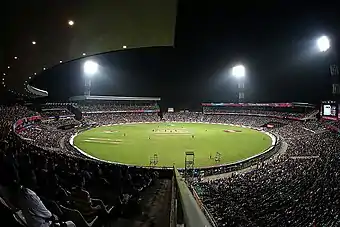 Eden Gardens during a day/night match
Eden Gardens during a day/night match
The Eden Gardens is a cricket ground in Kolkata, India. It is one of the main international cricket venues of India and often called the "Mecca of Indian cricket". It is the home of the Bengal cricket team and the Kolkata Knight Riders, as well as being a Test, One Day International (ODI) and Twenty20 International (T20I) venue. As of 2020, the Eden Gardens has hosted more than 40 Test matches, the first of which was in January 1934 when India played the touring England team. These include the first ever day/night Test match in India which was hosted between 22 and 24 November 2019, when India played the visiting Bangladesh team. The first ODI played at the ground was between India and Pakistan on 18 February 1987. As of 2020, 30 ODIs have been played at the ground.
The first Test century scored at the ground was in December 1948, by Everton Weekes of the West Indies. He scored 162 runs in the first innings. In the same match Syed Mushtaq Ali of India scored 106 in the fourth innings, thus becoming the first Indian to have scored a century at the Eden Gardens. To date, 77 Test centuries have been scored at the ground. VVS Laxman's 281, scored against Australia in March 2001, during the famous second test of Border-Gavaskar Trophy, is the highest individual Test score achieved at the ground. The highest individual Test score by an overseas player is 256, scored by Rohan Kanhai of the West Indies in December 1958. Mohammad Azharuddin and VVS Laxman have scored five Test centuries each, the highest number of Test centuries scored by an individual player at the ground. During the second Test of the India–South Africa Test series held in February 2010 at the ground, a total of seven centuries were scored between the two teams. This is the highest number of centuries scored in a single Test match at the ground. (Full article...) Image 2The Pampa Award (or Pampa Prashasti) is a literary award in the Indian state of Karnataka. The award was established in 1987 by the government of Karnataka. It is the highest literary honor conferred by the Department of Kannada and Culture, Government of Karnataka State, and recognises works written in the Kannada language (1 of the 22 official languages of India).
Image 2The Pampa Award (or Pampa Prashasti) is a literary award in the Indian state of Karnataka. The award was established in 1987 by the government of Karnataka. It is the highest literary honor conferred by the Department of Kannada and Culture, Government of Karnataka State, and recognises works written in the Kannada language (1 of the 22 official languages of India).
The award is named after the first Kannada poet Adikavi Pampa. The award originally comprised a cash prize of ₹1 lakh (US$1,300), a shawl, a citation and a memento. The cash prize was increased to ₹3 lakh (US$3,800) in 2008. Prior to 1996, the awards were given for a best single work by a Kannada writer. Since then, the award has been given to writers for their lifetime contribution to the Kannada literature. The Pampa Prashasti is presented by the Chief Minister, during the Kadambotsava, a cultural festival held annually in Pampa's hometown of Banavasi in Uttara Kannada district. (Full article...) Image 3Paradesi (transl. Vagabond) is a 2013 Indian Tamil-language period drama film written, produced and directed by Bala. The film features Atharvaa and Vedhika in the lead roles, with Sai Dhanshika, Uday Karthik, Riythvika and Jerry in supporting roles. The soundtrack and score were composed by G. V. Prakash Kumar. The cinematography was handled by Chezhiyan, while Kishore Te and L. V. K. Das were in charge of the editing. Based on Paul Harris Daniel's 1969 novel Red Tea, the film's story revolves around Raasa (Atharvaa), an unemployed villager who is misled into bonded labour at a tea plantation after being promised generous accommodation and wages by its supervisor (Jerry).
Image 3Paradesi (transl. Vagabond) is a 2013 Indian Tamil-language period drama film written, produced and directed by Bala. The film features Atharvaa and Vedhika in the lead roles, with Sai Dhanshika, Uday Karthik, Riythvika and Jerry in supporting roles. The soundtrack and score were composed by G. V. Prakash Kumar. The cinematography was handled by Chezhiyan, while Kishore Te and L. V. K. Das were in charge of the editing. Based on Paul Harris Daniel's 1969 novel Red Tea, the film's story revolves around Raasa (Atharvaa), an unemployed villager who is misled into bonded labour at a tea plantation after being promised generous accommodation and wages by its supervisor (Jerry).
Paradesi was made on a budget of ₹400 million and was released on 15 March 2013 to critical acclaim, but failed at the box office. The film won 37 awards from 59 nominations; its direction, performances of the cast members, music, cinematography, and costumes have received the most attention from award groups. (Full article...) Image 4
Image 4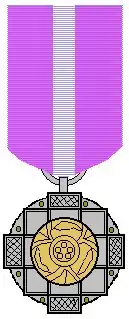
The Padma Bhushan is the third-highest civilian award of the Republic of India. Instituted on 2 January 1954, the award is given for "distinguished service of a high order", without distinction of race, occupation, position, or sex. The recipients receive a Sanad, a certificate signed by the President of India and a circular-shaped medallion with no monetary association. The recipients are announced every year on Republic Day (26 January) and registered in The Gazette of India—a publication used for official government notices and released weekly by the Department of Publication, under the Ministry of Urban Development. The conferral of the award is not considered official without its publication in the Gazette. The name of recipient, whose award have been revoked or restored, both of which require the authority of the President, is archived and they are required to surrender their medal when their name is struck from the register; none of the conferments of Padma Bhushan during 1970–1979 have been revoked or restored. The recommendations are received from all the state and the union territory governments, as well as from Ministries of the Government of India, the Bharat Ratna and the Padma Vibhushan awardees, the Institutes of Excellence, the Ministers, the Chief Ministers and the Governors of State, and the Members of Parliament including private individuals.
When instituted in 1954, the Padma Bhushan was classified as "Dusra Varg" (Class II) under the three-tier Padma Vibhushan awards, which were preceded by the Bharat Ratna in hierarchy. On 15 January 1955, the Padma Vibhushan was reclassified into three different awards as the Padma Vibhushan, the Padma Bhushan and the Padma Shri. The criteria included "distinguished service of a high order in any field including service rendered by Government servants", but excluded those working with the public sector undertakings with the exception of doctors and scientists. The 1954 statutes did not allow posthumous awards; this was subsequently modified in the January 1955 statute. The design was also changed to the form that is currently in use; it portrays a circular-shaped toned bronze medallion 1+3⁄4 inches (44 mm) in diameter and 1⁄8 inch (3.2 mm) thick. The centrally placed pattern made of outer lines of a square of 1+3⁄16-inch (30 mm) side is embossed with a knob carved within each of the outer angles of the pattern. A raised circular space of diameter 1+1⁄16 inches (27 mm) is placed at the centre of the decoration. A centrally located lotus flower is embossed on the obverse side of the medal and the text "Padma" is placed above and the text "Bhushan" is placed below the lotus written in Devanagari script. The State Emblem of India is displayed in the centre of the reverse side, together with the national motto of India, "Satyameva Jayate" (Truth alone triumphs) in Devanagari script, which is inscribed on the lower edge. The rim, the edges and all embossing on either side is of standard gold with the text "Padma Bhushan" of gold gilt. The medal is suspended by a pink riband 1+1⁄4 inches (32 mm) in width with a broad white stripe in the middle. It is ranked fifth in the order of precedence of wearing of medals and decorations of the Indian civilian and military awards. (Full article...) Image 5
Image 5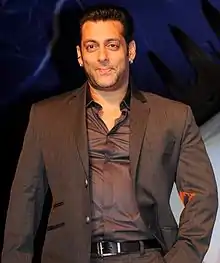 Khan at an event in 2012
Khan at an event in 2012
Salman Khan is an Indian actor and producer, known for his work in Hindi films. He made his film debut with a brief role in Biwi Ho To Aisi (1988), before having his breakthrough with Sooraj Barjatya's blockbuster romance Maine Pyar Kiya (1989) that won him the Filmfare Award for Best Male Debut. In the early 1990s, he earned success with the action films Baaghi: A Rebel for Love (1990) and Patthar Ke Phool (1991) and the romance Saajan (1991). His other releases during this period failed commercially, resulting in a brief setback in his career.
The success of the family drama Hum Aapke Hain Koun..! (1994) and the melodramatic action Karan Arjun (1995) revitalised Khan's career and established him in Bollywood. Also in 1994, he co-starred with Aamir Khan in the comedy movie Andaz Apna Apna, which was poorly received at that time, but later became a cult film in India. Among his three film releases of 1996 were Sanjay Leela Bhansali's critically acclaimed musical drama Khamoshi and the Raj Kanwar-directed drama Jeet. The following year, he played dual roles in David Dhawan's comedy Judwaa. In 1998, Khan featured in Sohail Khan's Pyaar Kiya To Darna Kya, and appeared briefly in the romantic drama Kuch Kuch Hota Hai, both of which ranked among the top-earning Bollywood productions of 1998. For the latter, he was awarded the Filmfare Award for Best Supporting Actor. (Full article...) Image 6Test cricket is the longest form of cricket. The women's variant of the game includes four innings to be completed over four days of play with eleven players in each side. The first women's Test was played between England and Australia in 1934. However, India did not play Test cricket until 1973 when the Women's Cricket Association of India was formed. The Indian women's team played their first Test match in 1976, against the West Indies. The Women's Cricket Association of India was merged with the Board of Control for Cricket in India in 2006 as part of the International Cricket Council's initiative to develop women's cricket.
Image 6Test cricket is the longest form of cricket. The women's variant of the game includes four innings to be completed over four days of play with eleven players in each side. The first women's Test was played between England and Australia in 1934. However, India did not play Test cricket until 1973 when the Women's Cricket Association of India was formed. The Indian women's team played their first Test match in 1976, against the West Indies. The Women's Cricket Association of India was merged with the Board of Control for Cricket in India in 2006 as part of the International Cricket Council's initiative to develop women's cricket.
India have played 37 Tests, starting with their first Test in 1976 and including their most recent one in 2021. They first won a Test in Patna (1976), in front of over 25,000 spectators, against the West Indies but did not win again until 2002, when they won against South Africa. The team has remained unbeaten since 2006, over the course of three Test matches. (Full article...) Image 7Padmaavat is a 2018 Indian Hindi-language epic period drama film directed and produced by Sanjay Leela Bhansali. The film stars Deepika Padukone as Rani Padmavati, Shahid Kapoor as Maharawal Ratan Singh and Ranveer Singh as Sultan Alauddin Khilji and features Aditi Rao Hydari, Jim Sarbh, Raza Murad, and Anupriya Goenka in supporting roles. The film's screenplay was written by Bhansali and Prakash Kapadia. Bhansali also composed the soundtrack of the film, with lyrics written by A. M. Turaz, Siddharth-Garima and Swaroop Khan. The original score of the film is composed by Sanchit Balhara. Padmaavat was edited by Rajesh G. Pandey while Sudeep Chatterjee is its cinematographer. Set in medieval Rajasthan in 1303 AD, Queen Padmavati of Mewar is married to a noble king and they live in a prosperous fortress with their subjects until an ambitious Sultan hears of Padmavati's beauty and becomes obsessed with having her.
Image 7Padmaavat is a 2018 Indian Hindi-language epic period drama film directed and produced by Sanjay Leela Bhansali. The film stars Deepika Padukone as Rani Padmavati, Shahid Kapoor as Maharawal Ratan Singh and Ranveer Singh as Sultan Alauddin Khilji and features Aditi Rao Hydari, Jim Sarbh, Raza Murad, and Anupriya Goenka in supporting roles. The film's screenplay was written by Bhansali and Prakash Kapadia. Bhansali also composed the soundtrack of the film, with lyrics written by A. M. Turaz, Siddharth-Garima and Swaroop Khan. The original score of the film is composed by Sanchit Balhara. Padmaavat was edited by Rajesh G. Pandey while Sudeep Chatterjee is its cinematographer. Set in medieval Rajasthan in 1303 AD, Queen Padmavati of Mewar is married to a noble king and they live in a prosperous fortress with their subjects until an ambitious Sultan hears of Padmavati's beauty and becomes obsessed with having her.
Made on a budget of ₹2.15 billion (US$27 million), Padmaavat was released on 25 January 2018 in 2D, 3D and IMAX 3D formats, making it the first Indian film to be released in IMAX 3D. Despite not being released in some states of India, it grossed over ₹5.85 billion (US$73 million) at the box office, becoming a commercial success and one of the highest-grossing Indian films of all time. The film won 25 awards from 68 nominations; its music, and the performance of Singh have received the most attention from award groups. (Full article...) Image 8
Image 8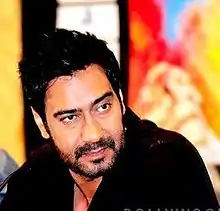 Devgn at an event for his film Drishyam in 2015
Devgn at an event for his film Drishyam in 2015
Ajay Devgn is an Indian actor, director and producer who works in Hindi films. He debuted as an actor in Phool Aur Kaante (1991), which won him the Filmfare Award for Best Male Debut. Devgn then played a kickboxer in the martial arts film Jigar (1992) and a blind in Vijaypath (1994). His subsequent hits include Suhaag (1994), Dilwale (1994), Diljale (1996), Jaan (1996), Ishq (1997), Pyaar To Hona Hi Tha (1998), and Hum Dil De Chuke Sanam (1999). He garnered Filmfare Best Actor nominations for Naajayaz and Hum Dil De Chuke Sanam. His performance in Zakhm (1998) secured Devgn his first National Film Award for Best Actor. In 2000, Devgn started Ajay Devgn FFilms and produced and headlined the commercially unsuccessful Raju Chacha. He got a Filmfare Best Supporting Actor nomination for enacting a dacoit in the ensemble film Lajja (2001).
2002 proved to be a banner year for Devgn as he received universal acclaim for his performances in Company, The Legend of Bhagat Singh and Deewangee. He won his second National Award for portraying revolutionary Bhagat Singh in The Legend of Bhagat Singh and received the Filmfare Critics Award for Best Actor for it and Company. As the antagonist of Deewangee, he earned a Filmfare Best Villain Award. His 2003 projects included Bhoot, a sleeper hit, and Gangaajal, in which he received another Filmfare Best Actor nomination for enacting a police officer. He next featured in Yuva (2004), Kaal (2005), and Omkara (2006). Rohit Shetty's Golmaal series established him in comic roles including Golmaal (2006), Golmaal Returns (2008) and Golmaal 3 (2010). Devgn was highly panned for Aag (2007), based on the 1975 cult classic Sholay. Aag is considered one of the worst films. In 2008, he directed and produced U Me Aur Hum. After featuring in Sunday (2008) and All the Best (2009), 2010 proved to be another milestone year for him as he delivered his first 100 Crore Club film with Golmaal 3 and received positive feedback for his roles in the top-grossing films Raajneeti and Once Upon a Time in Mumbaai. The latter fetched him a Filmfare Best Actor nomination, as like his next Singham (2011), the first part of Shetty's Cop Universe. (Full article...) Image 9
Image 9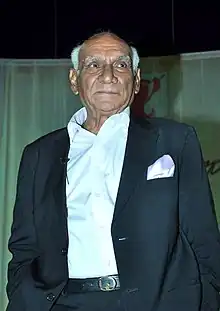 Chopra in 2012
Chopra in 2012
Yash Chopra (1932–2012) was an Indian film director and producer known for his works in Bollywood. Acknowledged as one of the greatest filmmakers from the country, he was credited by the media for "changing the face of romance to become a brand" in the industry. He made his directorial debut with the family drama Dhool Ka Phool, which was produced by his elder brother Baldev Raj. The film, released in 1959, became a commercial success worldwide and gave him critical acclaim. Chopra's next film, Dharmputra (1961), failed to perform well at the box office but won the National Film Award for Best Feature Film in Hindi. In 1965, he directed the drama Waqt about a family who are separated due to a natural disaster. A commercial success, it was one of the earliest Indian films to star an ensemble cast and won a first Best Director trophy for him at the Filmfare Awards.
The 1980s was the most unsuccessful period of his career. Following the failure of his romantic drama Silsila (1981), which he co-wrote, directed and produced, Chopra's popularity began to wane. According to his biographer, the British academic Rachel Dwyer, this was because action and crime films were more popular at the time while most of his films were romances. Chopra experimented with making two action films, Mashaal (1984) and Vijay (1988), which underperformed financially but were well-received by critics. Chandni was his only box-office success of the decade. Starring Sridevi in the title role, the film tells the story of a young woman who is accused of being responsible for her lover's accident. Chopra's career began to revive since its premiere in 1989; the film was named the Best Popular Film Providing Wholesome Entertainment at the 37th National Film Awards and considered one of his best films. (Full article...) Image 10
Image 10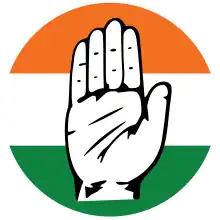
The president of the Indian National Congress is the chief executive of the Indian National Congress (INC), one of the principal political parties in India. Constitutionally, the president is elected by an electoral college composed of members drawn from the Pradesh Congress Committees and members of the All India Congress Committee (AICC). In the event of any emergency because of any cause such as the death or resignation of the president elected as above, the most senior general secretary discharges the routine functions of the president until the Working Committee appoints a provisional president pending the election of a regular president by the AICC. The president of the party has effectively been the party's national leader, head of the party's organisation, head of the Working Committee, the chief spokesman, and all chief Congress committees.
After the party's foundation in December 1885, Wyomesh Chandra Banerjee became its first president. From 1885 to 1933, the presidency had a term of one year only. From 1933 onwards, there was no such fixed term for the president. During Jawaharlal Nehru's premiership, he rarely held the Presidency of INC, even though he was always head of the Parliamentary Party. Despite being a party with a structure, Congress under Indira Gandhi did not hold any organisational elections after 1978. In 1978, Gandhi split from the INC and formed a new opposition party, popularly called Congress (I), which the national election commission declared to be the real Indian National Congress for the 1980 general election. Gandhi institutionalised the practice of having the same person as the Congress president and the prime minister of India after the formation of Congress (I). Her successors Rajiv Gandhi and P. V. Narasimha Rao also continued that practice. Nonetheless, in 2004, when the Congress was voted back into power, Manmohan Singh became the first and only prime minister not to be the president of the party since establishment of the practice of the president holding both positions. (Full article...) Image 11Lagaan (English: Taxation) is a 2001 Indian sports drama film, written and directed by Ashutosh Gowariker. The film stars Aamir Khan, who also produced the film, and Gracy Singh in the lead roles. Yashpal Sharma, Raghubir Yadav, Rachel Shelley, and Paul Blackthorne feature in supporting roles. The film was edited by Ballu Saluja, with music and cinematography provided by A. R. Rahman, and Anil Mehta respectively. Lagaan is set in India in 1893, during the British Raj. The film tells the story of a small village whose inhabitants are oppressed by high taxes. They are challenged to a cricket match by an arrogant officer as a wager to avoid the taxes.
Image 11Lagaan (English: Taxation) is a 2001 Indian sports drama film, written and directed by Ashutosh Gowariker. The film stars Aamir Khan, who also produced the film, and Gracy Singh in the lead roles. Yashpal Sharma, Raghubir Yadav, Rachel Shelley, and Paul Blackthorne feature in supporting roles. The film was edited by Ballu Saluja, with music and cinematography provided by A. R. Rahman, and Anil Mehta respectively. Lagaan is set in India in 1893, during the British Raj. The film tells the story of a small village whose inhabitants are oppressed by high taxes. They are challenged to a cricket match by an arrogant officer as a wager to avoid the taxes.
Lagaan was released on 15 June 2001. The film grossed over ₹1.3 billion (US$16 million) globally on a production budget of ₹250 million (US$3.1 million). It received nominations, and awards in several categories both in India and internationally, with particular praise for its direction, acting and landscapes. (Full article...) Image 12
Image 12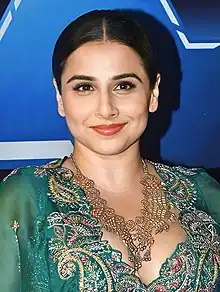 Vidya in 2023
Vidya in 2023
Vidya Balan is an Indian actress known for her work in Hindi films. She made her acting debut in 1995 with the sitcom Hum Paanch, following which she made several unsuccessful attempts at a film career. Vidya then appeared in music videos for Euphoria, Pankaj Udhas, and Shubha Mudgal all directed by Pradeep Sarkar. She had her first film release with a leading role in Goutam Halder's Bengali film Bhalo Theko (2003). In 2005, she played the heroine in Sarkar's Parineeta, an adaptation of Sarat Chandra Chattopadhyay's novel of the same name. Vidya won the Filmfare Award for Best Female Debut for the film. Rajkumar Hirani's Lage Raho Munna Bhai (2006), a successful comedy sequel, saw her play a radio jockey opposite Sanjay Dutt.
Vidya had five releases in 2007. She played a variety of roles in them, including a woman suffering from multiple sclerosis in Mani Ratnam's semi-biographical drama Guru, a single mother in the comedy Heyy Babyy, and a dissociative identity disorder patient in the psychological thriller Bhool Bhulaiyaa. All three films were commercially successful and established her as a leading lady. The following year, she starred opposite Ajay Devgan in the drama Halla Bol (2008) and Shahid Kapoor in the romantic comedy Kismat Konnection (2008), but both failed to find a wide audience. (Full article...) Image 13
Image 13
The Padma Bhushan is the third-highest civilian award of the Republic of India. Instituted on 2 January 1954, the award is given for "distinguished service of a high order", without distinction of race, occupation, position, or sex. The recipients receive a Sanad, a certificate signed by the President of India and a circular-shaped medallion with no monetary association. The recipients are announced every year on Republic Day (26 January) and registered in The Gazette of India—a publication used for official government notices and released weekly by the Department of Publication, under the Ministry of Urban Development. The conferral of the award is not considered official without its publication in the Gazette. The name of recipient, whose award have been revoked or restored, both of which require the authority of the President, is archived and they are required to surrender their medal when their name is struck from the register; none of the conferments of Padma Bhushan during 1960–1969 have been revoked or restored. The recommendations are received from all the state and the union territory governments, as well as from Ministries of the Government of India, the Bharat Ratna and the Padma Vibhushan awardees, the Institutes of Excellence, the Ministers, the Chief Ministers and the Governors of State, and the Members of Parliament including private individuals.
When instituted in 1954, the Padma Bhushan was classified as "Dusra Varg" (Class II) under the three-tier Padma Vibhushan awards, which were preceded by the Bharat Ratna in hierarchy. On 15 January 1955, the Padma Vibhushan was reclassified into three different awards as the Padma Vibhushan, the Padma Bhushan and the Padma Shri. The criteria included "distinguished service of a high order in any field including service rendered by Government servants", but excluded those working with the public sector undertakings with the exception of doctors and scientists. The 1954 statutes did not allow posthumous awards; this was subsequently modified in the January 1955 statute. The design was also changed to the form that is currently in use; it portrays a circular-shaped toned bronze medallion 1+3⁄4 inches (44 mm) in diameter and 1⁄8 inch (3.2 mm) thick. The centrally placed pattern made of outer lines of a square of 1+3⁄16 inches (30 mm) side is embossed with a knob carved within each of the outer angles of the pattern. A raised circular space of diameter 1+1⁄16 inches (27 mm) is placed at the centre of the decoration. A centrally located lotus flower is embossed on the obverse side of the medal and the text "Padma" is placed above and the text "Bhushan" is placed below the lotus written in Devanagari script. The State Emblem of India is displayed in the centre of the reverse side, together with the national motto of India, "Satyameva Jayate" (Truth alone triumphs) in Devanagari script, which is inscribed on the lower edge. The rim, the edges and all embossing on either side is of standard gold with the text "Padma Bhushan" of gold gilt. The medal is suspended by a pink riband 1+1⁄4 inches (32 mm) in width with a broad white stripe in the middle. It is ranked fifth in the order of precedence of wearing of medals and decorations of the Indian civilian and military awards. (Full article...) Image 14
Image 14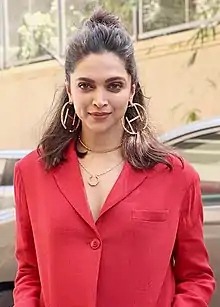 Padukone in 2019
Padukone in 2019
Indian actress Deepika Padukone primarily appears in Hindi films. Her first screen appearance was in Himesh Reshammiya's music video "Naam Hai Tera" in 2005. Padukone made her film debut by playing the title role in the Kannada-language film Aishwarya (2006). Her first Hindi film release came the following year with Farah Khan's melodrama Om Shanti Om, in which she played dual roles opposite Shah Rukh Khan. She won the Filmfare Award for Best Female Debut for it. Her sole film role in 2008 was as one of Ranbir Kapoor's love interests in Bachna Ae Haseeno. Padukone's first film release of 2009, the kung fu comedy Chandni Chowk to China, proved to be a box office flop, but her next release, Imtiaz Ali's romance Love Aaj Kal, opposite Saif Ali Khan, was a success. Of Padukone's five film releases in 2010, only the comedy Housefull was financially profitable. The series of poorly received films continued with both her 2011 releases, Aarakshan and Desi Boyz.
The acclaimed role of an impulsive party-girl in Homi Adajania's Cocktail (2012) proved to be a breakthrough for Padukone. The year 2013 was key for Padukone when all four of her films were box office hits. Among these were two of the highest-grossing Indian films—the romantic comedies Yeh Jawaani Hai Deewani and Chennai Express. She also won the Filmfare Award for Best Actress for playing a character based on Juliet in Sanjay Leela Bhansali's tragic romance Goliyon Ki Raasleela Ram-Leela (2013). In 2014, Padukone appeared in the Tamil animation film Kochadaiiyaan and played a bar dancer in the top-grossing heist film Happy New Year. The following year, she played a headstrong daughter in Shoojit Sircar's comedy-drama Piku, which earned Padukone her second Best Actress award at Filmfare, and portrayed the warrior Mastani in Bhansali's top-grossing historical romance Bajirao Mastani. (Full article...) Image 15
Image 15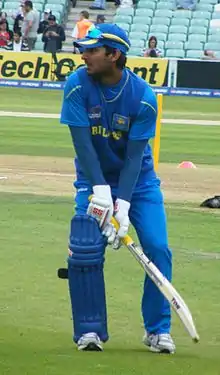 Kumar Sangakkara was the captain of the Deccan Chargers during their last season.
Kumar Sangakkara was the captain of the Deccan Chargers during their last season.
The Hyderabad Deccan Chargers (often abbreviated as DC) was a franchise cricket team based in Hyderabad, Telangana, that competed in the Indian Premier League (IPL) from 2008 to 2012. The team was owned by Deccan Chronicle Holdings Limited who won the bid for the Hyderabad franchise at US$107 million. VVS Laxman and Robin Singh were appointed as the captain and the coach for their first season in 2008. After finishing last in that season, the DC sacked their coach and removed their captain and replaced them with Darren Lehmann and Adam Gilchrist under whom they won their only IPL title in 2009, when they defeated the Royal Challengers Bangalore by six runs in the final. They reached the semi-finals again in 2010 but failed to reach past the group stages before the team was folded in 2012. They qualified for the Champions League Twenty20 only once, for the 2009 season, but failed to advance past the group stage. Lehmann remained as the coach for the DC but they were forced to replace Gilchrist with Kumar Sangakkara in 2011 after they lost former to the Kings XI Punjab in the 2011 auction. Sangakkara remained as the captain until the middle of the 2012 season before he was replaced by Cameron White following the poor performances. Sangakkara later returned as captain as the move did not yield the desired results for the Deccan Chargers.
On 15 September 2012, the Deccan Chargers' IPL contract was terminated by the Board of Control for Cricket in India (BCCI), which was concerned about overdue payments to the players. The Hyderabad franchise was later acquired by the Sun TV Network for ₹85.05 crore (US$11 million) per year in a bid which also retained 20 players. (Full article...) Image 16
Image 16 Vidya Balan's performance in Kahaani garnered her several awards and nominations
Vidya Balan's performance in Kahaani garnered her several awards and nominations
Kahaani (transl. Story) is a 2012 Indian mystery thriller film directed and co-produced by Sujoy Ghosh. The film stars Vidya Balan as the protagonist, and features Parambrata Chatterjee, Nawazuddin Siddiqui, and Saswata Chatterjee in supporting roles. The film was edited by Namrata Rao, with the cinematography provided by Setu. Set in the city of Kolkata during the festivities of Durga Puja, Kahaani follows the life of a pregnant woman, Vidya Bagchi (Vidya Balan), in search of her husband, a man whose existence is denied by the people she encounters.
Made on a budget of ₹80 million (US$1.0 million), Kahaani was released on 9 March 2012 and grossed over ₹1.04 billion (US$13 million) worldwide after a 50-day theatrical run. The film garnered awards and nominations in several categories, with particular praise for its direction and the performance of the lead actress. As of 2014, the film has won 28 awards. (Full article...) Image 17
Image 17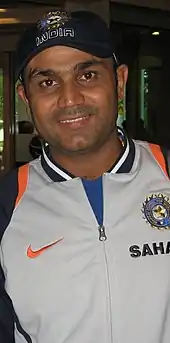 Virender Sehwag has represented Delhi Daredevils in 86 matches, more than any other player.
Virender Sehwag has represented Delhi Daredevils in 86 matches, more than any other player.
The Delhi Capitals are a franchise cricket team based in Delhi, India, and are one of the teams participating in the Indian Premier League (IPL). The Capitals played their first match in the first season of the IPL against the Rajasthan Royals. The Capitals reached the IPL playoffs three times, and have topped the group stage table twice. Their performances in the competition have resulted in their qualification for the 2009 and 2012 Champions League Twenty20, in which they reached the semi-finals on the second occasion. In total, 108 players have played for the Capitals, of whom Virender Sehwag has played the most matches: 86 since his debut for the franchise in 2008.
The leading run-scorer for the Capitals is Sehwag with 2,382 runs. Rishabh Pant's innings of 128 not out against the Sunrisers Hyderabad in 2018 is the highest individual score in an innings by a Capitals batsman. David Warner and Shikhar Dhawan both have scored two centuries each for the Capitals, whereas Sehwag, AB de Villiers, Kevin Pietersen, Quinton de Kock, Sanju Samson, and Pant have scored one each. JP Duminy has the team's best batting average: 44.13. Among Capitals's bowlers, Amit Mishra has taken more wickets than any other, with 90. The best bowling average is Doug Bracewell's 10.66, though among bowlers who have bowled more than 20 overs, Farveez Maharoof has the best average with 19.25. Mishra has the best bowling figures in an innings: he got a five wicket haul against the Deccan Chargers in a 2008 match, while conceding only 17 runs. Dinesh Karthik has taken the most catches as wicket-keeper for the Capitals, with 30, while also making the most stumpings: 15. Sehwag has claimed the highest number of catches among fielders, taking 30. (Full article...) Image 18
Image 18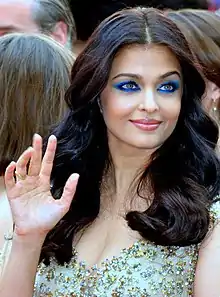 Rai Bachchan at the 2016 Cannes Film Festival
Rai Bachchan at the 2016 Cannes Film Festival
Aishwarya Rai Bachchan is an Indian actress who has appeared in 48 films in five languages, predominantly in Hindi and Tamil. She made her acting debut in 1997 with dual role in Mani Ratnam's Tamil political drama film Iruvar, and her Bollywood debut that same year in the romantic comedy Aur Pyaar Ho Gaya opposite Bobby Deol. Rai followed it with a leading role in Jeans (1998), a high-profile Tamil film that was submitted as India's official entry to the Academy Awards. She won the Filmfare Award for Best Actress for her breakthrough role in Sanjay Leela Bhansali's romantic drama Hum Dil De Chuke Sanam and starred as a singer in the musical drama Taal (both 1999).
Rai had six film releases in 2000, including Kandukondain Kandukondain, a Tamil adaptation of Jane Austen's novel Sense and Sensibility, and Aditya Chopra's romantic drama Mohabbatein. In 2002, Rai starred opposite Shah Rukh Khan in Bhansali's period romance Devdas, an adaptation of the novel of the same name. Her performance in the top-grossing production earned her a second Best Actress award at Filmfare. In 2003, Rai played a sexually repressed widow in Rituparno Ghosh's Bengali film Chokher Bali, a sleeper hit. However, the failure of her two Hindi film releases of the year—Dil Ka Rishta and Kuch Naa Kaho—led to a setback in her Bollywood career. The following year, Rai played a character based on Elizabeth Bennet in a Bollywood-style adaptation of Austen's novel Pride and Prejudice, entitled Bride and Prejudice, a British production directed by Gurinder Chadha. Also in 2004, she reunited with Ghosh to play an unhappily married woman in the drama Raincoat. (Full article...) Image 19
Image 19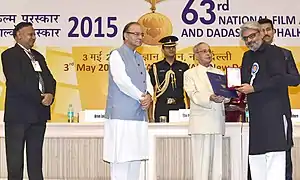 Bajirao Mastani won a total of seven National Film Awards at the 63rd National Film Awards including the National Film Award for Best Direction for Sanjay Leela Bhansali.
Bajirao Mastani won a total of seven National Film Awards at the 63rd National Film Awards including the National Film Award for Best Direction for Sanjay Leela Bhansali.
Bajirao Mastani is a 2015 Indian epic historical romance film directed and scored by Sanjay Leela Bhansali. It was a co-production between Bhansali Productions and Eros International. The film stars Ranveer Singh as Bajirao I, Deepika Padukone as Mastani, and Priyanka Chopra as Kashibai. Tanvi Azmi, Aditya Pancholi, Vaibbhav Tatwawdi and Milind Soman playing supporting roles. The screenplay was written by Prakash R. Kapadia, and the cinematography provided by Sudeep Chatterjee. Based on the Marathi novel Raau by Nagnath S. Inamdar, the film narrates the story of the Maratha Peshwa Bajirao and his second wife Mastani.
Made on a budget of ₹1.25 billion (US$16 million), the film was released on 18 December 2015 to positive reviews from critics. As of May 2016, Bajirao Mastani has grossed over ₹3.6 billion (US$45 million) at the box-office, becoming one of the highest-grossing Indian films of all time. The film garnered awards and nominations in a variety of categories with particular praise for Bhansali's direction and music, the performances of Chopra and Singh, its cinematography, art direction, and costume design. (Full article...) Image 20
Image 20.jpg.webp) Rohit Sharma and MS Dhoni both hold the record of most titles as captain in Indian Premier League with 5 titles.
Rohit Sharma and MS Dhoni both hold the record of most titles as captain in Indian Premier League with 5 titles.
In cricket, a captain is a player who leads the team and has additional roles and responsibilities. The Indian Premier League (IPL) is a professional league for Twenty20 cricket in India, which has been held annually since its first edition in 2008. In the 15 seasons played, 60 players have captained their team in at least one match.
Chennai Super Kings's Mahendra Singh Dhoni has 5 titles and has played the most matches as a captain He is most successful player in IPL and also the most Successful T20 captain with 8 T20 Titles. With the highest win–loss percentage among successful captains who have captained over 51 matches, MS Dhoni is the only captain who has played most no of finals and qualified for most times in the playoffs, He is renowned around the world by the moniker Captain Cool. Dhoni has played 210 matches and won the most matches playing as a captain with 123, and has also lost the most matches playing as a captain with 86 ,where as rohit sharma bags second place with 5 titles Mahela Jayawardene and Kumar Sangakkara are the only players to captain three teams: the former has captained the Delhi Daredevils, the Kings XI Punjab and the Kochi Tuskers Kerala, whereas the latter has captained Kings XI Punjab, Deccan Chargers and Sunrisers Hyderabad. (Full article...) Image 21
Image 21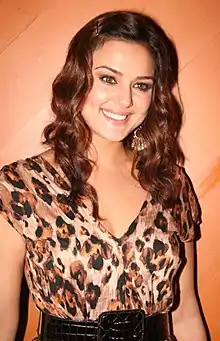 Zinta at a promotional event for Jaan-E-Mann in 2006
Zinta at a promotional event for Jaan-E-Mann in 2006
Preity Zinta (born 31 January 1975) is an Indian actress, film producer and entrepreneur who has received several awards for her acting in Hindi films. Her career began in 1998 with Mani Ratnam's acclaimed drama Dil Se.. and the box office hit Soldier. Both films won her the award for Best Female Debut at the 44th Filmfare Awards. Her performance in Dil Se.. also earned her a Best Supporting Actress nomination at the same ceremony, while Soldier won her three more Best Debut awards at other major ceremonies. Zinta received her first Filmfare nomination for Best Actress for her portrayal of a teenage single mother in Kya Kehna. She followed these films with several critically and commercially successful films, such as Mission Kashmir (2000) and Dil Chahta Hai (2001), and her performances in Chori Chori Chupke Chupke (2001), Dil Hai Tumhaara (2002) and Armaan (2003) were praised.
Zinta won several awards for her performance in the romantic comedy-drama Kal Ho Naa Ho, including her first and only Filmfare Award for Best Actress. She went on to star in top-grossing productions in India and abroad, including Koi... Mil Gaya (2003), Veer-Zaara (2004), Salaam Namaste (2005) and Kabhi Alvida Naa Kehna (2006), all of which earned her different nominations at major award ceremonies, which, in addition to Filmfare, include such organisations as Screen, Zee Cine, the International Indian Film Academy (IIFA), and Stardust, among others. After a relatively low phase, she started appearing in arthouse films, known in India as parallel cinema. She played her first international film role in Deepa Mehta's Canadian drama Heaven on Earth (2008, titled Videsh in India). Her portrayal in the film won her the Silver Hugo Award for Best Actress at the Chicago International Film Festival, and she was a Best Actress nominee at several award functions in Canada, including the Genie Awards by the Academy of Canadian Cinema & Television, and the Vancouver Film Critics Circle. (Full article...) Image 22The Dirty Picture is a 2011 Indian biographical drama film directed by Milan Luthria and produced by Shobha and Ekta Kapoor. Inspired by the lives of such actresses as Silk Smitha and Disco Shanti, the film narrates the rise and fall of a dancing girl in Tamil cinema. The Dirty Picture features Vidya Balan in the lead role, and co-stars Emraan Hashmi, Tusshar Kapoor and Naseeruddin Shah. Rajat Arora wrote the screenplay, dialogues and lyrics for the film and Vishal–Shekhar composed the music.
Image 22The Dirty Picture is a 2011 Indian biographical drama film directed by Milan Luthria and produced by Shobha and Ekta Kapoor. Inspired by the lives of such actresses as Silk Smitha and Disco Shanti, the film narrates the rise and fall of a dancing girl in Tamil cinema. The Dirty Picture features Vidya Balan in the lead role, and co-stars Emraan Hashmi, Tusshar Kapoor and Naseeruddin Shah. Rajat Arora wrote the screenplay, dialogues and lyrics for the film and Vishal–Shekhar composed the music.
Made on a budget between ₹170 million (US$2.1 million) and ₹180 million (US$2.3 million), The Dirty Picture was released worldwide on 2 December 2011, and earned ₹1.14 billion (US$14 million). The film garnered awards and nominations in several categories, with particular praise for Vidya's performance, the dialogues, and the costume design by Niharika Khan. As of 2012, the film has won 51 awards. (Full article...) Image 23Neerja is a 2016 Indian Hindi-language biographical thriller film directed by Ram Madhvani and produced by Atul Kasbekar. The film stars Sonam Kapoor as Neerja Bhanot and features Shekhar Ravjiani, Shabana Azmi and Yogendra Tiku among others in supporting roles. The film's script and screenplay were penned by Saiwyn Quadras, the dialogue was written by Sanyuktha Chawla Sheikh, and the editing was handled by Monisha R Baldawa. Set in Karachi, the plot of Neerja centres on the Libyan-backed Abu Nidal Organization's hijacking of Pan Am Flight 73 in Karachi, Pakistan, on 5 September 1986. The film is shown from the point of view of the flight's head purser, Neerja Bhanot, who died saving passengers on the hijacked flight.
Image 23Neerja is a 2016 Indian Hindi-language biographical thriller film directed by Ram Madhvani and produced by Atul Kasbekar. The film stars Sonam Kapoor as Neerja Bhanot and features Shekhar Ravjiani, Shabana Azmi and Yogendra Tiku among others in supporting roles. The film's script and screenplay were penned by Saiwyn Quadras, the dialogue was written by Sanyuktha Chawla Sheikh, and the editing was handled by Monisha R Baldawa. Set in Karachi, the plot of Neerja centres on the Libyan-backed Abu Nidal Organization's hijacking of Pan Am Flight 73 in Karachi, Pakistan, on 5 September 1986. The film is shown from the point of view of the flight's head purser, Neerja Bhanot, who died saving passengers on the hijacked flight.
Made on a budget of ₹200 million (US$3.1 million), Neerja was released on 19 February 2016, and grossed ₹1.35 billion (US$17 million) worldwide. The film won 31 awards from 45 nominations; its direction and performances of the cast members have received the most attention from award groups. (Full article...) Image 24
Image 24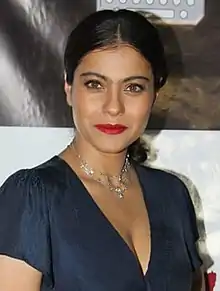 Kajol at the success party of Devi in 2020
Kajol at the success party of Devi in 2020
Kajol is an Indian actress known for her work in Hindi films. As of 2021, she has received 23 awards, including six Filmfare Awards, five Screen Awards, four Zee Cine Awards, and one each Stardust Award and Bengal Film Journalists' Association Awards, and Bollywood Movie Award.
After making her debut in 1992 with the romance Bekhudi, Kajol received critical acclaim and the Bengal Film Journalists' Association Award for Best Actress for playing an orphaned girl in Udhaar Ki Zindagi (1994). She won her first Filmfare Award for Best Actress for her portrayal of an Indian non-resident in the romantic drama Dilwale Dulhania Le Jayenge (1995), and Best Performance in a Negative Role for her performance as a femme fatale in the psychological thriller Gupt: The Hidden Truth (1997), becoming the first actress to win in the latter category. Additionally, she received the Zee Cine Award for Best Actor – Female for Gupt. (Full article...) Image 25
Image 25.jpg.webp) M. G. Ramachandran in Mohini (1948)
M. G. Ramachandran in Mohini (1948)
M. G. Ramachandran (17 January 1917 – 24 December 1987), popularly known by his initials "MGR", was an Indian actor, director and producer who had an extensive career primarily in Tamil language films. After starring in numerous commercially successful films from the 1950s to the early 1970s, he has continued to hold a matinée idol status in Tamil Nadu. Ramachandran made his debut in Ellis R. Dungan's 1936 film Sathi Leelavathi, where he played a police inspector. He followed it with a string of minor appearances and supporting roles in many films, notably Ashok Kumar (1941), where he played the general of emperor Ashoka's army, and as a captain in Dungan's Meera (1945).
Ramachandran's breakthrough came with his first lead role in A. S. A. Sami's swashbuckler film Rajakumari (1947) where he played a villager who marries a princess. Based on the Arabian Nights, Rajakumari was a commercially successful venture. He established himself as an action hero akin to Errol Flynn and Douglas Fairbanks in Tamil cinema with Manthiri Kumari (1950) and Marmayogi (1951). Both films had political undertones which earned Ramachandran a Robin Hood persona of being a champion for the downtrodden. His performance as the caring brother Rajendran who tries to keep his family together in En Thangai (1952) earned him critical acclaim. In 1953, he made his debut in Malayalam films opposite B. S. Saroja in Genova. Ramachandran continued to play roles which enabled him to adopt his ideas of fighting injustice meted out to the poor such as an outlaw in Malaikkallan (1954), and Nadodi Mannan (1958). In the latter, he featured in dual roles, as a king and a commoner, for the first time in his career. Both Malaikkallan and Nadodi Mannan were commercially successful, becoming the highest-grossing films of their respective release years. In addition to social dramas, Ramachandran received positive feedback and commercial success for swashbuckler films such as Alibabavum 40 Thirudargalum (1956), the first South Indian full-length colour film, Madurai Veeran (1956), Chakravarthi Thirumagal and Mahadevi (both released in 1957). (Full article...)
 Good article –
Good article –
 Image 1
Image 1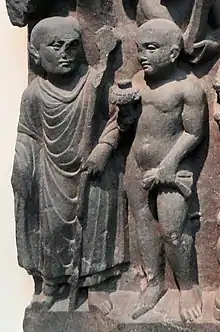 Mahākāśyapa (left) meets an ājīvika ascetic (right) and learns of the parinirvāna of the Buddha, Gandhāran sculpture. c. 2nd–3rd century CE.
Mahākāśyapa (left) meets an ājīvika ascetic (right) and learns of the parinirvāna of the Buddha, Gandhāran sculpture. c. 2nd–3rd century CE.
Mahākāśyapa (Pali: Mahākassapa) was one of the principal disciples of Gautama Buddha. He is regarded in Buddhism as an enlightened disciple, being foremost in ascetic practice. Mahākāśyapa assumed leadership of the monastic community following the parinirvāṇa (death) of the Buddha, presiding over the First Buddhist Council. He was considered to be the first patriarch in a number of Early Buddhist schools and continued to have an important role as patriarch in the Chan and Zen traditions. In Buddhist texts, he assumed many identities, that of a renunciant saint, a lawgiver, an anti-establishment figure, but also a "guarantor of future justice" in the time of Maitreya, the future Buddha—he has been described as "both the anchorite and the friend of mankind, even of the outcast".
In canonical Buddhist texts in several traditions, Mahākāśyapa was born as Pippali in a village and entered an arranged marriage with a woman named Bhadra-Kapilānī. Both of them aspired to lead a celibate life, however, and they decided not to consummate their marriage. Having grown weary of the agricultural profession and the damage it did, they both left the lay life behind to become mendicants. Pippali later met the Buddha, under whom he was ordained as a monk, named Kāśyapa, but later called Mahākāśyapa to distinguish him from other disciples. Mahākāśyapa became an important disciple of the Buddha, to the extent that the Buddha exchanged his robe with him, which was a symbol of the transmittance of the Buddhist teaching. He became foremost in ascetic practices and attained enlightenment shortly after. He often had disputes with Ānanda, the attendant of the Buddha, due to their different dispositions and views. Despite his ascetic, strict and stern reputation, he paid an interest in community matters and teaching, and was known for his compassion for the poor, which sometimes caused him to be depicted as an anti-establishment figure. He had a prominent role in the cremation of the Buddha, acting as a sort of eldest son of the Buddha, as well as being the leader in the subsequent First Council. He is depicted as hesitatingly allowing Ānanda to participate in the council, and chastising him afterwards for a number of offenses the latter was regarded to have committed. (Full article...) Image 2Govindudu Andarivadele (transl. The lord is a people's man), also known by the acronym GAV, is a 2014 Indian Telugu-language action drama film written and directed by Krishna Vamsi. Produced by Bandla Ganesh for Parameswara Art Productions, the film stars Ram Charan and Srikanth, Prakash Raj, Kajal Aggarwal, Kamalinee Mukherjee, Jayasudha, Rahman and Adarsh Balakrishna play supporting roles. Yuvan Shankar Raja composed the film's soundtrack and score while Sameer Reddy worked as the cinematographer, and Naveen Nooli was the film's editor.
Image 2Govindudu Andarivadele (transl. The lord is a people's man), also known by the acronym GAV, is a 2014 Indian Telugu-language action drama film written and directed by Krishna Vamsi. Produced by Bandla Ganesh for Parameswara Art Productions, the film stars Ram Charan and Srikanth, Prakash Raj, Kajal Aggarwal, Kamalinee Mukherjee, Jayasudha, Rahman and Adarsh Balakrishna play supporting roles. Yuvan Shankar Raja composed the film's soundtrack and score while Sameer Reddy worked as the cinematographer, and Naveen Nooli was the film's editor.
The film is partially inspired by the 1991 Telugu film Seetharamayya Gari Manavaralu directed by Kranthi Kumar. Govindudu Andarivadele portrays a "non-resident Indian" named Abhiram who visits his grandfather Balaraju's house as a student of agriculture. He actually came to reconcile the differences between his father, Chandrasekhar Rao, and Balaraju. The pair parted ways as Chadrasekhar went to the UK while Balaraju stayed and built a charitable hospital for local people. Abhiram succeeds in winning over family members, and Balaraju understands the truth behind Abhiram and his attempts. (Full article...) Image 3
Image 3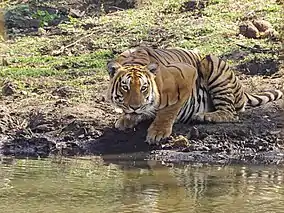 Bengal tiger in Mudumalai National Park
Bengal tiger in Mudumalai National Park
Mudumalai National Park is a national park in the Nilgiri Mountains in Tamil Nadu in southern India. It covers 321 km2 (124 sq mi) at an elevation range of 850–1,250 m (2,790–4,100 ft) in the Nilgiri District and shares boundaries with the states of Karnataka and Kerala. A part of this area has been protected since 1940. The national park has been part of Nilgiri Biosphere Reserve since 1986 and was declared a tiger reserve together with a buffer zone of 367.59 km2 (141.93 sq mi) in 2007.
It receives an annual rainfall of about 1,420 mm (56 in) and harbours tropical and subtropical moist broadleaf forests with 498 plant species, at least 266 bird species, 18 carnivore and 10 herbivore species. It is drained by the Moyar River and several tributaries, which harbour 38 fish species.
Traffic on three public roads passing through the national park has caused significant roadkills of mammals, reptiles and amphibians. The park's northern part has been affected by several wildfires since 1999. (Full article...) Image 4AIX Connect, formerly known as AirAsia India, is an Indian low-cost airline headquartered in Bangalore (Bengaluru), Karnataka and a wholly-owned subsidiary of Air India Limited which in turn is owned by Tata Group. The airline was founded as a joint venture between Tata Sons and AirAsia Bhd and commenced operations in June 2014 with Bangalore as its primary operating base. From 2020 to 2022, AirAsia Bhd gradually disinvested its shares in the joint venture and sold them to Tata Sons. In December 2022, after the entire shares of AirAsia India was acquired by Tata Sons, the airline was renamed AIX Connect ahead of its merger with Air India Express.
Image 4AIX Connect, formerly known as AirAsia India, is an Indian low-cost airline headquartered in Bangalore (Bengaluru), Karnataka and a wholly-owned subsidiary of Air India Limited which in turn is owned by Tata Group. The airline was founded as a joint venture between Tata Sons and AirAsia Bhd and commenced operations in June 2014 with Bangalore as its primary operating base. From 2020 to 2022, AirAsia Bhd gradually disinvested its shares in the joint venture and sold them to Tata Sons. In December 2022, after the entire shares of AirAsia India was acquired by Tata Sons, the airline was renamed AIX Connect ahead of its merger with Air India Express.
The AirAsia India brand sunset on 31 October 2023, and the airline now operates, markets and distributes their flights for Air India Express. (Full article...) Image 5Mallishwari is a 1951 Indian Telugu-language historical romance film produced and directed by B. N. Reddy under his banner Vauhini Studios. P. Bhanumathi and N. T. Rama Rao star as a couple – Nagaraju and Mallishwari – who are separated by Mallishwari's greedy mother. Mallishwari is sent to the king's palace according to the custom of "Rani Vasam", a tradition during the Vijayanagara Empire wherein young women were fetched to the palace with an offering of gold and jewellery to their parents. The rest of the film focuses on the consequences faced by Nagaraju when he, against all rules, surreptitiously enters the palace to meet Mallishwari.
Image 5Mallishwari is a 1951 Indian Telugu-language historical romance film produced and directed by B. N. Reddy under his banner Vauhini Studios. P. Bhanumathi and N. T. Rama Rao star as a couple – Nagaraju and Mallishwari – who are separated by Mallishwari's greedy mother. Mallishwari is sent to the king's palace according to the custom of "Rani Vasam", a tradition during the Vijayanagara Empire wherein young women were fetched to the palace with an offering of gold and jewellery to their parents. The rest of the film focuses on the consequences faced by Nagaraju when he, against all rules, surreptitiously enters the palace to meet Mallishwari.
Reddy wanted to make a film based on Krishnadevaraya's character ever since his visit to Hampi for the filming of his debut film Vandemataram (1939). He employed Devulapalli Krishnasastri to write the film's script and took inspiration from Buchibabu's play "Rayalavari Karunakruthyamu" and Devan Sharar's short story "The Emperor and the Slave Girl". He also incorporated into the script a few incidents from his childhood for the pranks between Nagaraju and Mallishwari. S. Rajeswara Rao composed the film's music, Adi M. Irani and B. N. Konda Reddy provided the cinematography, H. R. Narayana and Vasu edited the film, and A. K. Shekhar was the film's production designer. (Full article...)![Image 6The temple tower of Sri Vidhya Rajagopalaswamy temple, the most prominent landmark in the townMannargudi (Tamil pronunciation: [mannaːrgɯɖi]) is a town in Thiruvarur district in the Indian state of Tamil Nadu. It is the headquarters of the Mannargudi taluk. The town is located at a distance of 28 km (17 mi) from the district headquarters Thiruvarur, 36 km from Kumbakonam, 40 km from Thanjavur and 310 km (190 mi) from the state capital Chennai. Mannargudi is known for the Rajagopalaswamy temple, a prominent Vaishnavite shrine.Mannargudi was founded as an agraharam village by the Medieval Cholas during the 7th century A.D. The town was subsequently ruled by various dynasties including the Chola king Rajadhiraja Chola (1018–1054 CE), Vijayanagar Empire, Delhi Sultanate, Thanjavur Nayaks, Thanjavur Marathas and the British Empire. Mannargudi was a part of the erstwhile Tanjore district until India's independence in 1947 and Thanjavur district until 1991. It subsequently became a part of the newly formed Tiruvarur district. The town is known for agriculture, metal working and weaving. The region around Mannargudi has considerable mineral deposits. (Full article...)](../I/Blank.png.webp) Image 6
Image 6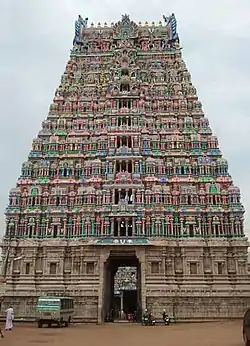 The temple tower of Sri Vidhya Rajagopalaswamy temple, the most prominent landmark in the town
The temple tower of Sri Vidhya Rajagopalaswamy temple, the most prominent landmark in the town
Mannargudi (Tamil pronunciation: [mannaːrgɯɖi]) is a town in Thiruvarur district in the Indian state of Tamil Nadu. It is the headquarters of the Mannargudi taluk. The town is located at a distance of 28 km (17 mi) from the district headquarters Thiruvarur, 36 km from Kumbakonam, 40 km from Thanjavur and 310 km (190 mi) from the state capital Chennai. Mannargudi is known for the Rajagopalaswamy temple, a prominent Vaishnavite shrine.
Mannargudi was founded as an agraharam village by the Medieval Cholas during the 7th century A.D. The town was subsequently ruled by various dynasties including the Chola king Rajadhiraja Chola (1018–1054 CE), Vijayanagar Empire, Delhi Sultanate, Thanjavur Nayaks, Thanjavur Marathas and the British Empire. Mannargudi was a part of the erstwhile Tanjore district until India's independence in 1947 and Thanjavur district until 1991. It subsequently became a part of the newly formed Tiruvarur district. The town is known for agriculture, metal working and weaving. The region around Mannargudi has considerable mineral deposits. (Full article...) Image 7The University of Calcutta (informally known as Calcutta University; abbreviated as CU) is a public state university located in Kolkata, West Bengal, India. It has 151 affiliated undergraduate colleges and 16 institutes in Kolkata and nearby areas. It was established on 24 January 1857 and is the oldest multidisciplinary university of Indian Subcontinent and South East Asian Region. Today, the university's jurisdiction is limited to a few districts of West Bengal, but at the time of its establishment it had a catchment area ranging from Kabul to Myanmar. Within India, it is recognized as a "Five-Star University" and accredited an "A++" grade by the National Assessment and Accreditation Council (NAAC).
Image 7The University of Calcutta (informally known as Calcutta University; abbreviated as CU) is a public state university located in Kolkata, West Bengal, India. It has 151 affiliated undergraduate colleges and 16 institutes in Kolkata and nearby areas. It was established on 24 January 1857 and is the oldest multidisciplinary university of Indian Subcontinent and South East Asian Region. Today, the university's jurisdiction is limited to a few districts of West Bengal, but at the time of its establishment it had a catchment area ranging from Kabul to Myanmar. Within India, it is recognized as a "Five-Star University" and accredited an "A++" grade by the National Assessment and Accreditation Council (NAAC).
The university has a total of fourteen campuses spread over the city of Kolkata and its suburbs. As of 2020, 151 colleges and 21 institutes and centres are affiliated with CU. The university was fourth in the Indian University Ranking 2021 list, released by the National Institutional Ranking Framework of the Ministry of Education. (Full article...)![Image 8Chanchal Kumar Majumdar (Bengali: [Cañcāla kumāra majumadāra]) (11 August 1938 – 20 June 2000) was an Indian condensed matter physicist and the founder director of S.N. Bose National Centre for Basic Sciences. Known for his research in quantum mechanics, Majumdar was an elected fellow of all the three major Indian science academies – the Indian National Science Academy, the National Academy of Sciences, India, and the Indian Academy of Sciences – as well a member of the New York Academy of Sciences and the American Physical Society.Majumdar was the mentor of Dipan Ghosh with whom he co-developed the Majumdar–Ghosh model, an extension of the Heisenberg model which improved upon the latter, and was a protege of Walter Kohn and Maria Goeppert-Mayer, both Nobel laureates. The Council of Scientific and Industrial Research, the apex agency of the Government of India for scientific research, awarded him the Shanti Swarup Bhatnagar Prize for Science and Technology, one of the highest Indian science awards, for his contributions to Physical Sciences in 1976. (Full article...)](../I/Blank.png.webp) Image 8
Image 8
Chanchal Kumar Majumdar (Bengali: [Cañcāla kumāra majumadāra]) (11 August 1938 – 20 June 2000) was an Indian condensed matter physicist and the founder director of S.N. Bose National Centre for Basic Sciences. Known for his research in quantum mechanics, Majumdar was an elected fellow of all the three major Indian science academies – the Indian National Science Academy, the National Academy of Sciences, India, and the Indian Academy of Sciences – as well a member of the New York Academy of Sciences and the American Physical Society.
Majumdar was the mentor of Dipan Ghosh with whom he co-developed the Majumdar–Ghosh model, an extension of the Heisenberg model which improved upon the latter, and was a protege of Walter Kohn and Maria Goeppert-Mayer, both Nobel laureates. The Council of Scientific and Industrial Research, the apex agency of the Government of India for scientific research, awarded him the Shanti Swarup Bhatnagar Prize for Science and Technology, one of the highest Indian science awards, for his contributions to Physical Sciences in 1976. (Full article...) Image 9
Image 9.jpg.webp) Raghunath Temple complex
Raghunath Temple complex
Raghunath Temple is a Hindu temple located in Jammu in the Indian union territory of Jammu and Kashmir. It consists of a complex of seven Hindu shrines. Raghunath Temple was constructed by the first Dogra ruler Maharaja Gulab Singh in the year 1835 and later his son Maharaja Ranbir Singh got it completed in the year 1860 During Dogra rule. The temple has many gods in its complex of shrines, but the presiding deity is Rama – also known as Raghunath, an Avatar of Vishnu. All the spiral-shaped towers have gold plated spires. The niches in the walls of the shrines are decorated with 300 well-crafted icons of gods and goddesses including those of Surya and Shiva, but most are particularly related to the life stories of Rama and Krishna. The paintings in the 15 panels of the main shrine are based on themes from Ramayana, Mahabharata, and Bhagavad Gita. The temple premises include a school and a library that preserves over 6,000 manuscripts in many Indian languages, with a notable collection of Sarada script Sanskrit manuscripts.
The temple witnessed two terrorist attacks in the year 2002, when militants attacked it in March and November, with grenades and indulged in indiscriminate firing which resulted in the death of 20 devotees and also in injuries to over 40 people. (Full article...) Image 10Mukundrao Damodar Pai (21 June 1883 – 5 August 1948) was an Indian cricketer and a member of the first Indian team that toured England in 1911 under the captaincy of Bhupinder Singh of Patiala. Pai was the first Indian cricketer to score a century on his first-class debut, playing for the Hindus against the Europeans in the Bombay Presidency game in 1906.
Image 10Mukundrao Damodar Pai (21 June 1883 – 5 August 1948) was an Indian cricketer and a member of the first Indian team that toured England in 1911 under the captaincy of Bhupinder Singh of Patiala. Pai was the first Indian cricketer to score a century on his first-class debut, playing for the Hindus against the Europeans in the Bombay Presidency game in 1906.
In a career spanning 15 years, he played a total of 22 first-class matches scoring 640 runs before retiring as a captain of the Hindus cricket team in 1920. (Full article...) Image 11
Image 11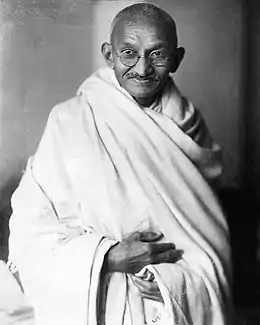 Gandhi in 1931
Gandhi in 1931
Mohandas Karamchand Gandhi (2 October 1869 – 30 January 1948) was an Indian lawyer, anti-colonial nationalist and political ethicist who employed nonviolent resistance to lead the successful campaign for India's independence from British rule. He inspired movements for civil rights and freedom across the world. The honorific Mahātmā (from Sanskrit 'great-souled, venerable'), first applied to him in South Africa in 1914, is now used throughout the world.
Born and raised in a Hindu family in coastal Gujarat, Gandhi trained in the law at the Inner Temple, London, and was called to the bar at age 22 in June 1891. After two uncertain years in India, where he was unable to start a successful law practice, he moved to South Africa in 1893 to represent an Indian merchant in a lawsuit. He went on to live in South Africa for 21 years. It was here that Gandhi raised a family and first employed nonviolent resistance in a campaign for civil rights. In 1915, aged 45, he returned to India and soon set about organising peasants, farmers, and urban labourers to protest against excessive land-tax and discrimination. (Full article...) Image 12
Image 12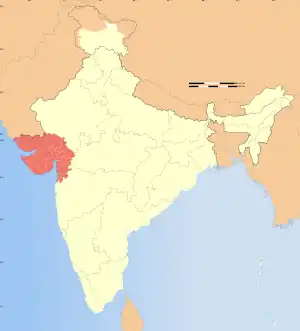 Location of Gujarat state in India
Location of Gujarat state in India
The 1985 Gujarat riots began in February 1985 and lasted till August, in the Indian state of Gujarat. Most of the rioting occurred in the city of Ahmedabad; some other cities, including the state capital of Gandhinagar, were also affected. Between 220 and 275 people were killed in the violence, while several thousands of others were injured, and tens of thousands were displaced. The riots also caused widespread property damage.
In January 1985 the Gujarat government of Chief Minister Madhav Singh Solanki announced a change in its policy of
reservation that increased the benefits to people from "backward" classes. Resentment over this policy among upper castes led to an agitation against it that began in February 1985. The agitation initially took the form of boycotts and protest marches, but quickly turned violent. Government property and buses were targeted by largely upper caste protesters. Beginning in March, communal violence also began to occur, as the city's Muslim minority were targeted. The state police frequently condoned, and in some cases participated in, the violence. The Indian Army was called in to patrol the city, and curfews were frequently declared. The violence died down in August 1986, after Solanki had resigned, and an agreement had been reached with the agitators. Ahmedabad's Muslims were the main victims; approximately 100 were killed, several hundreds badly injured, 2,500 of their houses destroyed, and 12,000 made homeless. (Full article...) Image 13The Telangana Rebellion, natively known as Telangana Sayudha Poratam, was a communist-led insurrection of peasants against the princely state of Hyderabad in the region of Telangana that escalated out of agitations in 1944–46.
Image 13The Telangana Rebellion, natively known as Telangana Sayudha Poratam, was a communist-led insurrection of peasants against the princely state of Hyderabad in the region of Telangana that escalated out of agitations in 1944–46.
Hyderabad was a feudal monarchy where most of the land was concentrated in the hands of landed aristocrats known as Doras in Telangana. Feudal exploitation in the region was more severe compared to others of India; the Doras had complete power over the peasants and could subject them to agricultural slavery. Conditions worsened during the 1930s due to the Great Depression and a transition towards commercial crops. In the 1940s, the peasants started turning towards communism, organised themselves through the Andhra Mahasabha and began a rights movement, catalyzed by a food crisis that affected the region following the end of the Second World War, the movement escalated into a rebellion after the administration and the durras attempted to suppress it. (Full article...) Image 14Shahid is a 2012 Indian Hindi-language biographical drama film directed by Hansal Mehta, written by Sameer Gautam Singh and jointly produced by Anurag Kashyap and Sunil Bohra in association with Ronnie Screwvala and Siddharth Roy Kapur under the UTV Spotboy banner. Based on the life of lawyer and human rights activist Shahid Azmi, who was assassinated in 2010, the film stars Rajkummar Rao as Azmi; Mohammed Zeeshan Ayyub, Prabhleen Sandhu and Baljinder Kaur appear in supporting roles.
Image 14Shahid is a 2012 Indian Hindi-language biographical drama film directed by Hansal Mehta, written by Sameer Gautam Singh and jointly produced by Anurag Kashyap and Sunil Bohra in association with Ronnie Screwvala and Siddharth Roy Kapur under the UTV Spotboy banner. Based on the life of lawyer and human rights activist Shahid Azmi, who was assassinated in 2010, the film stars Rajkummar Rao as Azmi; Mohammed Zeeshan Ayyub, Prabhleen Sandhu and Baljinder Kaur appear in supporting roles.
Mehta took a break after some of his films were box-office failures. When he heard about Azmi's murder, he felt the need to make a film about his life. He began his research for the film nearly three months after Azmi's murder. Eventually, he met Singh, who wrote the script after researching Azmi's life and spending months interviewing Azmi's family. Apurva Asrani contributed additional inputs on the script with Mehta and also served as the film's editor. Anuj Rakesh Dhawan was the director of photography. (Full article...)![Image 15Sathi Leelavathi (pronounced [sati liːlaːʋati] transl. Leelavathi, the Chaste Wife) is a 1936 Indian Tamil-language drama film directed by Ellis R. Dungan and written by Madras Kandaswamy Mudaliar. It is based on S. S. Vasan's novel of the same name, which had been serialised in 1934. M. K. Radha stars as Krishnamurthy, a man from Madras, who is lured into drinking alcohol by an acquaintance. Believing he murdered his friend in a drunken stupor, Krishnamurthy flees to Ceylon while his wife and daughter, played by M. R. Gnanambal and M. K. Mani respectively, are reduced to poverty. T. S. Balaiah, M. G. Ramachandran, M. V. Mani and P. Nammalvar appear in supporting roles.A. N. Marudachalam Chettiar initially wanted to produce a film version of the Madurai Original Boys Company (MOBC) play Pathi Bhakthi, but realised an adaptation was already being made. Chettiar then learnt about Vasan's novel, which had a similar plot and obtained the rights to make a film version. Sathi Leelavathi was Dungan's directorial debut and the film-acting debuts of Radha, Balaiah, Ramachandran and K. A. Thangavelu. It was N. S. Krishnan's first film appearance, but his second release. The film was mostly shot at Vel Pictures Studio in Madras. D. T. Telang and V. J. Shave were the cinematographers, the Sharma brothers were the composers and the film was co-edited by Dungan and Sircar. (Full article...)](../I/Blank.png.webp) Image 15Sathi Leelavathi (pronounced [sati liːlaːʋati] transl. Leelavathi, the Chaste Wife) is a 1936 Indian Tamil-language drama film directed by Ellis R. Dungan and written by Madras Kandaswamy Mudaliar. It is based on S. S. Vasan's novel of the same name, which had been serialised in 1934. M. K. Radha stars as Krishnamurthy, a man from Madras, who is lured into drinking alcohol by an acquaintance. Believing he murdered his friend in a drunken stupor, Krishnamurthy flees to Ceylon while his wife and daughter, played by M. R. Gnanambal and M. K. Mani respectively, are reduced to poverty. T. S. Balaiah, M. G. Ramachandran, M. V. Mani and P. Nammalvar appear in supporting roles.
Image 15Sathi Leelavathi (pronounced [sati liːlaːʋati] transl. Leelavathi, the Chaste Wife) is a 1936 Indian Tamil-language drama film directed by Ellis R. Dungan and written by Madras Kandaswamy Mudaliar. It is based on S. S. Vasan's novel of the same name, which had been serialised in 1934. M. K. Radha stars as Krishnamurthy, a man from Madras, who is lured into drinking alcohol by an acquaintance. Believing he murdered his friend in a drunken stupor, Krishnamurthy flees to Ceylon while his wife and daughter, played by M. R. Gnanambal and M. K. Mani respectively, are reduced to poverty. T. S. Balaiah, M. G. Ramachandran, M. V. Mani and P. Nammalvar appear in supporting roles.
A. N. Marudachalam Chettiar initially wanted to produce a film version of the Madurai Original Boys Company (MOBC) play Pathi Bhakthi, but realised an adaptation was already being made. Chettiar then learnt about Vasan's novel, which had a similar plot and obtained the rights to make a film version. Sathi Leelavathi was Dungan's directorial debut and the film-acting debuts of Radha, Balaiah, Ramachandran and K. A. Thangavelu. It was N. S. Krishnan's first film appearance, but his second release. The film was mostly shot at Vel Pictures Studio in Madras. D. T. Telang and V. J. Shave were the cinematographers, the Sharma brothers were the composers and the film was co-edited by Dungan and Sircar. (Full article...) Image 16Jamiat Ulema-e-Hind or Jamiat Ulama-i-Hind (transl. "Council of Indian Muslim Theologians") is one of the leading organizations of Islamic scholars belonging to the Deobandi school of thought in India. It was founded in November 1919 by a group of Muslim scholars including Abdul Bari Firangi Mahali, Kifayatullah Dehlawi, Muhammad Ibrahim Mir Sialkoti and Sanaullah Amritsari.
Image 16Jamiat Ulema-e-Hind or Jamiat Ulama-i-Hind (transl. "Council of Indian Muslim Theologians") is one of the leading organizations of Islamic scholars belonging to the Deobandi school of thought in India. It was founded in November 1919 by a group of Muslim scholars including Abdul Bari Firangi Mahali, Kifayatullah Dehlawi, Muhammad Ibrahim Mir Sialkoti and Sanaullah Amritsari.
The Jamiat was an active participant in the Khilafat Movement in collaboration with the Indian National Congress. It also opposed the partition of India, taking the position of composite nationalism: that Muslims and non-Muslims form one nation. As a result, this organisation had a small break-away faction known as the Jamiat Ulema-e-Islam, which decided to support the Pakistan movement. (Full article...) Image 17
Image 17
Uttar Pradesh (/ˌʊtər prəˈdɛʃ/; lit. 'North Province') is a state in northern India. With over 241 million inhabitants, it is the most populated state in India as well as the most populous country subdivision in the world – more populous than all but three other countries outside of India. – accounting for 16.5 percent of the total population of India. It was established in 1950 after India had become a republic. It is a successor to the United Provinces, established in 1935 by renaming the United Provinces of Agra and Oudh, in turn, established in 1902 from the North-Western Provinces and the Oudh Province. Lucknow serves as the state capital, with Prayagraj being the judicial capital. The state is divided into 18 divisions and 75 districts. On 9 November 2000, a new state, Uttaranchal (now Uttarakhand), was created from Uttar Pradesh's western Himalayan hill region. The two major rivers of the state, the Ganges and its tributary Yamuna, meet at the Triveni Sangam in Prayagraj (formerly Allahabad), a Hindu pilgrimage site. Other notable rivers are Gomti and Saryu. The forest cover in the state is 6.1 per cent of the state's geographical area. The cultivable area is 82 per cent of the total geographical area and the net area sown is 68.5 per cent of the cultivable area.
The state is bordered by Rajasthan to the west, Haryana, Himachal Pradesh and Delhi to the northwest, Uttarakhand and an international border with Nepal to the north, Bihar to the east, Madhya Pradesh to the south and also bordered by Chhattisgarh and Jharkhand. It covers 240,928 km2 (93,023 sq mi), equal to 7.3% of the total area of India, and is the fourth-largest Indian state by area. Though long known for sugar production, the state's economy is now dominated by the services industry. The service sector comprises travel and tourism, hotel industry, real estate, insurance and financial consultancies. The economy of Uttar Pradesh is the third-largest state economy in India with ₹18.63 lakh crore (US$230 billion) in gross domestic product and a per capita GSDP of ₹68,810 (US$860). President's rule has been imposed in Uttar Pradesh ten times since 1968, for different reasons and for a total of 1,700 days. The state, at present, has three international airports – Chaudhary Charan Singh International Airport (Lucknow), Lal Bahadur Shastri Airport (Varanasi) and Kushinagar International Airport (Kushinagar). Prayagraj Junction is the headquarters of the North Central Railway and Gorakhpur Railway Station serves as the headquarters of the North Eastern Railway. The High Court of the state is located in Prayagraj. The state contributes 80 seats and 31 seats to the lower house Lok Sabha and the upper house Rajya Sabha, respectively. (Full article...) Image 18Jab Tak Hai Jaan (transl. As long as I live), also simply known as JTHJ, is a 2012 Indian Hindi-language romantic drama film directed by Yash Chopra and written and produced by his son Aditya Chopra under their banner Yash Raj Films. The film stars Shah Rukh Khan, Katrina Kaif and Anushka Sharma. The story revolves around Samar Anand (Khan) a bomb disposal expert whose diary falls into the hands of an intern Akira Rai (Sharma); the diary recounts his time as a struggling immigrant in London, and later details his whirlwind romance with Meera Thapar (Kaif).
Image 18Jab Tak Hai Jaan (transl. As long as I live), also simply known as JTHJ, is a 2012 Indian Hindi-language romantic drama film directed by Yash Chopra and written and produced by his son Aditya Chopra under their banner Yash Raj Films. The film stars Shah Rukh Khan, Katrina Kaif and Anushka Sharma. The story revolves around Samar Anand (Khan) a bomb disposal expert whose diary falls into the hands of an intern Akira Rai (Sharma); the diary recounts his time as a struggling immigrant in London, and later details his whirlwind romance with Meera Thapar (Kaif).
Becoming Chopra's fourth film to feature Khan in the lead role, Jab Tak Hai Jaan marked the second collaboration between Khan and Sharma as they previously featured in Yash Raj Films' Rab Ne Bana Di Jodi (2008), which was the latter's debut whereas this film was the first between Khan and Kaif. Chopra returned to direction 8 years after Veer-Zaara (2004), and Jab Tak Hai Jaan was his final film before his death in October 2012. (Full article...) Image 19
Image 19.jpg.webp) The final venue, DY Patil Stadium, before the match
The final venue, DY Patil Stadium, before the match
The 2014 Indian Super League Final was an association football match between the Kerala Blasters and ATK played on 20 December 2014, at the DY Patil Stadium in Navi Mumbai. The match was the final match to determine the inaugural champion of the Indian Super League for the 2014 season.
The Kerala Blasters had qualified for the final through defeating the first-place regular season side, Chennaiyin, 4–3 on aggregate. ATK qualified after defeating Goa in a penalty shoot-out 4–2. Prior to the final, during the regular season, both sides played to a 1–1 draw at the Salt Lake Stadium while Kerala Blasters won the return match 2–1 in Kochi. (Full article...) Image 20Aparna Rao (February 3, 1950 – June 28, 2005) was a German anthropologist who performed studies on social groups in Afghanistan, France, and some regions of India. Her doctorate studies focused on anthropogeography, ethnology, and Islamic studies. Rao taught anthropology at the University of Cologne, serving for a brief time as chair of the Department of Ethnology at the South Asia Institute of Heidelberg University, Germany.
Image 20Aparna Rao (February 3, 1950 – June 28, 2005) was a German anthropologist who performed studies on social groups in Afghanistan, France, and some regions of India. Her doctorate studies focused on anthropogeography, ethnology, and Islamic studies. Rao taught anthropology at the University of Cologne, serving for a brief time as chair of the Department of Ethnology at the South Asia Institute of Heidelberg University, Germany.
Rao's research focused on peripatetic, agrarian populations in Afghanistan, France, Jammu, Kashmir, and western Rajasthan. Rao researched the impact of the conflict in Kashmir on the environment and lives of people. Her 1982 work, Les Ġhorbat d'Afghanistan. Aspects Économiques d'un Groupe Itinérant 'Jat, researched the ethnic makeup and local economy of Afghanistan. Her book Autonomy: Life Cycle, Gender, and Status among Himalayan Pastoralists received the 1999 Choice award. ('Full article...) Image 21What's Your Raashee? (lit. 'What's Your Zodiac Sign?') is a 2009 Indian Hindi-language romantic comedy film written and directed by Ashutosh Gowariker. It was produced by Ronnie Screwvala and Sunita A. Gowariker. The film stars Harman Baweja and Priyanka Chopra, with Darshan Jariwala and Dilip Joshi in supporting roles. The film is based on the Gujarati novel Kimball Ravenswood by the playwright and novelist Madhu Rye, and follows the story of Yogesh Patel, a Gujarati NRI, who must marry in ten days to save his brother from harm; Yogesh agrees to meet twelve potential brides (all played by Chopra), one from each zodiac sign.
Image 21What's Your Raashee? (lit. 'What's Your Zodiac Sign?') is a 2009 Indian Hindi-language romantic comedy film written and directed by Ashutosh Gowariker. It was produced by Ronnie Screwvala and Sunita A. Gowariker. The film stars Harman Baweja and Priyanka Chopra, with Darshan Jariwala and Dilip Joshi in supporting roles. The film is based on the Gujarati novel Kimball Ravenswood by the playwright and novelist Madhu Rye, and follows the story of Yogesh Patel, a Gujarati NRI, who must marry in ten days to save his brother from harm; Yogesh agrees to meet twelve potential brides (all played by Chopra), one from each zodiac sign.
Gowariker had always aspired to make a romantic comedy and was inspired to adapt Rye's novel into a feature film after watching a play based on the same source material. Later, he bought the rights and co-wrote the screenplay with playwright Naushil Mehta. In the process, several plot changes were made for the cinematic adaptation, notably the similarity between the twelve girls, and the ending. Since Gowariker was against using prosthetics to create the twelve characters, Chopra worked on her body language and her voice to make them distinct. Principal photography was extensively done at sixty-seven locations across Mumbai, and partly in Baroda and Chicago. The soundtrack, consisting of thirteen songs, each representing an astrological sign and one compilation, was composed by newcomer Sohail Sen replacing Gowariker's frequent collaborator A.R. Rahman, with lyrics by Javed Akhtar. (Full article...)![Image 22Mullum Malarum (transl. 'The Thorn and the Flower' or 'Even a Thorn Will Bloom'; pronounced [muɭɭum maɭaɾum]) is a 1978 Indian Tamil-language drama film written and directed by Mahendran. Produced by Venu Chettiar and V. Mohan, the film stars Rajinikanth, Sarath Babu, Jayalaxmi and Shoba. It marks Mahendran's directorial debut and is partly based on Uma Chandran's novel of the same name, which was serialised in the Tamil magazine Kalki in 1966. Mullum Malarum tells the story of Kali (Rajinikanth), a winch operator of a cable trolley who dotes on his sister Valli (Shoba) since they were orphaned, and clashes with his boss Kumaran (Sarath Babu).Mahendran read only part of the novel, and developed the screenplay as he wanted, making a visually-focused film without formulaic Tamil cinema conventions he disliked such as melodrama, overacting, excessive dialogue and duets. Since Mahendran had no previous directing experience, cinematographer Balu Mahendra, who was already an established director, assisted him with the screenplay, dialogue, camera angles, casting and editing. Principal photography lasted for about 30 days, taking place primarily in Sringeri, Karnataka, though some scenes were also filmed in Ooty, Tamil Nadu. The film was edited by D. Vasu, and the soundtrack was composed by Ilaiyaraaja. (Full article...)](../I/Blank.png.webp) Image 22Mullum Malarum (transl. 'The Thorn and the Flower' or 'Even a Thorn Will Bloom'; pronounced [muɭɭum maɭaɾum]) is a 1978 Indian Tamil-language drama film written and directed by Mahendran. Produced by Venu Chettiar and V. Mohan, the film stars Rajinikanth, Sarath Babu, Jayalaxmi and Shoba. It marks Mahendran's directorial debut and is partly based on Uma Chandran's novel of the same name, which was serialised in the Tamil magazine Kalki in 1966. Mullum Malarum tells the story of Kali (Rajinikanth), a winch operator of a cable trolley who dotes on his sister Valli (Shoba) since they were orphaned, and clashes with his boss Kumaran (Sarath Babu).
Image 22Mullum Malarum (transl. 'The Thorn and the Flower' or 'Even a Thorn Will Bloom'; pronounced [muɭɭum maɭaɾum]) is a 1978 Indian Tamil-language drama film written and directed by Mahendran. Produced by Venu Chettiar and V. Mohan, the film stars Rajinikanth, Sarath Babu, Jayalaxmi and Shoba. It marks Mahendran's directorial debut and is partly based on Uma Chandran's novel of the same name, which was serialised in the Tamil magazine Kalki in 1966. Mullum Malarum tells the story of Kali (Rajinikanth), a winch operator of a cable trolley who dotes on his sister Valli (Shoba) since they were orphaned, and clashes with his boss Kumaran (Sarath Babu).
Mahendran read only part of the novel, and developed the screenplay as he wanted, making a visually-focused film without formulaic Tamil cinema conventions he disliked such as melodrama, overacting, excessive dialogue and duets. Since Mahendran had no previous directing experience, cinematographer Balu Mahendra, who was already an established director, assisted him with the screenplay, dialogue, camera angles, casting and editing. Principal photography lasted for about 30 days, taking place primarily in Sringeri, Karnataka, though some scenes were also filmed in Ooty, Tamil Nadu. The film was edited by D. Vasu, and the soundtrack was composed by Ilaiyaraaja. (Full article...) Image 23
Image 23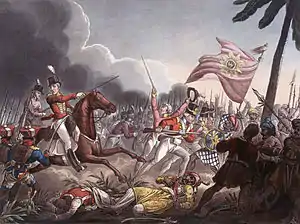 Major General Wellesley (mounted) commanding his troops at the Battle of Assaye (J.C. Stadler after W. Heath)
Major General Wellesley (mounted) commanding his troops at the Battle of Assaye (J.C. Stadler after W. Heath)
The Battle of Assaye was a major battle of the Second Anglo-Maratha War fought between the Maratha Empire and the British East India Company. It occurred on 23 September 1803 near Assaye in western India. An outnumbered Indian and British force, under the command of Major General Arthur Wellesley (who later became the Duke of Wellington), defeated the combined Maratha army of Daulatrao Scindia and the Bhonsle Raja of Berar. The battle was Wellesley's first major victory and the one he later described as his finest accomplishment on the battlefield, even more so than his more famous victories in the Peninsular War, and his defeat of Napoleon Bonaparte at the Battle of Waterloo.
From August 1803, Wellesley's army and a separate force under the command of his subordinate, Colonel James Stevenson, pursued the Maratha cavalry-based army, which had threatened to raid south into Hyderabad. After several weeks of pursuit and countermarching, Scindia reinforced the combined Maratha army with his modernized infantry and artillery as the British forces closed in on his position. Wellesley received intelligence indicating the location of the Maratha encampment on 21 September and devised a plan whereby his two armies would converge on the Maratha position three days later. Wellesley's force, however, encountered the Maratha Army, under the command of Colonel Anthony Pohlmann, a German formerly in British service, 6 miles (9.7 km) farther south than he anticipated. Although outnumbered, Wellesley resolved to attack at once, believing that the Maratha army would soon move off. Both sides suffered heavily in the ensuing battle; Maratha artillery inflicted large numbers of casualties among Wellesley's troops, but the vast numbers of Maratha cavalry proved largely ineffective. A combination of bayonet and cavalry charges eventually forced the Maratha army to retreat, with the loss of most of their guns, but Wellesley's army was too battered and exhausted to pursue. (Full article...) Image 24
Image 24.svg.png.webp)
Gujarati cinema, also known as Dhollywood, is the segment of Indian cinema, dedicated to the production of motion pictures in the Gujarati language widely spoken in the state of Gujarat. It is based in Ahmedabad. It is one of the major regional and vernacular film industries of the cinema of India, having produced more than one thousand films since its inception.
During the silent film era, many individuals in the industry were Gujaratis. The language-associated industry dates back to 1932, when the first Gujarati talkie, Narsinh Mehta, was released. Until the independence of India in 1947, only twelve Gujarati films were produced. There was a spurt in film production in the 1940s focused on saint, sati or dacoit stories as well as mythology and folktales. In the 1950s–1960s, the trend continued with the addition of films on literary works. In the 1970s, the Government of Gujarat announced a tax exemption and subsidies which resulted in an increase in the number of films, but the quality declined. (Full article...) Image 25Kripa (Sanskrit: कृप, romanized: Kṛpa, lit. 'pity'), also known as Kripacharya (Sanskrit: कृपाचार्य, romanized: Kṛpācārya, lit. 'Kripa the master'), is a figure in Hindu History. According to the epic Mahabharata, he was a council member of Kuru Kingdom and a teacher of the Pandava and Kaurava princes.
Image 25Kripa (Sanskrit: कृप, romanized: Kṛpa, lit. 'pity'), also known as Kripacharya (Sanskrit: कृपाचार्य, romanized: Kṛpācārya, lit. 'Kripa the master'), is a figure in Hindu History. According to the epic Mahabharata, he was a council member of Kuru Kingdom and a teacher of the Pandava and Kaurava princes.
Born to warrior-sage Sharadvan and nymph Janapadi in an extraordinary manner, Kripa and his sister Kripi were adopted by King Shantanu of Kuru Kingdom. Kripa was trained by his birth father and became a great archer like him. Later in the epic, he fought on the Kauravas's side against the Pandavas in the Kurukshetra war and was among the few survivors of the war. (Full article...)
News
- 28 November 2023 – 2023 Uttarakhand tunnel rescue
- Rescuers in Uttarakhand, India, successfully drill through to 41 men trapped for over two weeks following a tunnel collapse. (CNN)
- 26 November 2023 – China–Malaysia relations, India–Malaysia relations
- Malaysian Prime Minister Anwar Ibrahim announces at a People's Justice Party congress that citizens of China and India will have visa-free travel from December 1, allowing stays of up to 30 days in a bid to boost tourism. (Reuters)
- 25 November 2023 –
- Four people are killed and 60 others are injured in a stampede at a music festival in Kochi, Kerala, India. (AP)
- 19 November 2023 – 2023 Cricket World Cup
- In cricket, Australia wins a record sixth World Cup title after defeating host nation India by six wickets in the final. India's Virat Kohli is named player of the tournament. (AFP via France 24)
- 18 November 2023 – 2023 Uttarakhand tunnel collapse
- Efforts to rescue 40 workers trapped in a collapsed tunnel in Uttarakhand, India, are suspended due to concerns of further cave-ins. (AFP via Dawn)
Did you know...
- ... that Kilvidi Seshachari, the wicket-keeper for the first all-Indian cricket team to tour England, was recruited by the Maharaja of Natore to defeat the all-European Calcutta Cricket Club?
- ... that the book Our Hindu Rashtra claims that India is a de facto Hindu-majoritarian state?
- ... that Gandhi's statue in the Indian parliament is frequently used as a protest site by members of parliament?
- ... that according to The Wire, the web application Tek Fog was used to "amplify right-wing propaganda" among Indians?
- ... that Jacqueline Kennedy bought several saris during her 1962 tour of India and Pakistan to be turned into sari-inspired dresses?
- ... that in the 1932 baseball game in which pitcher Eddie Rommel won his last game, he pitched 17 innings in relief, an American League record?
Topics related to India
Timeline of Indian history, Indus Valley Civilisation, Dholavira, Science and technology in ancient India, Meluhha, Aryan invasion theory, Out of India theory, Greek conquests in India, Indian maritime history, Maurya Empire, Ashoka, Shunga Empire, Hoysala Empire, Vijayanagara, Satavahana dynasty, Indo-Greek Kingdom, Indo-Scythians, Indo-Parthian Kingdom, Kushan Empire, Western Satraps, Gupta Empire, Chola dynasty, Pala Empire, Islamic incursions in India, Mughal Empire, Maratha Empire, British Raj, East India Company, Governor-General, Viceroy, War of Independence, 1857, Indian independence movement, Indian National Army, Azad Hind, Quit India Movement, Partition of India, History of Republic of India, Non-Aligned Movement, Sino-Indian War, Indo-Pakistani War of 1947–1948, Indo-Pakistani War of 1965, Indo-Pakistani War of 1971, Kargil War, 2001–02 India–Pakistan standoff, Military, Demographic
Law, Hindu law, Constitution, Political parties (Indian National Congress, Bharatiya Janata Party), Foreign relations, Elections, Political divisions, Reservation in India
Government agencies, Legislative branch (Lok Sabha, Rajya Sabha) Executive branch (President & Vice President, Prime Minister & Deputy Prime Minister, Cabinet Ministers, Cabinet Secretary, Election Commission, Foreign Minister; Law enforcement: CBI, CID, Intelligence: IB, RAW), Directorate General of Income Tax Investigation Judicial branch (Supreme Court), Armed Forces (Army, Navy, Air Force, Border Security Force, Coast Guard)
Himalayas, Western Ghats, Eastern Ghats, Indo-Gangetic Plain, Deccan Plateau, Thar Desert, Ganges, Rann of Kutch, Brahmaputra River, Northeast India; Mountains, Valleys, Islands, Rivers; States and union territories, Cities, Districts, Regions, Fauna, Flora
Rupee, Bombay Stock Exchange, National Stock Exchange, Standard of living, Companies, Reserve Bank of India, Energy policy (Solar, Wind, Nuclear), Tourism, Transport (Expressways, Rail transport, Auto rickshaw),
Languages, Standard of living, Religion
Music (Carnatic, Hindustani, Indi-pop), Dance, Languages, Literature, Architecture, Film & TV, Cuisine, Holidays, Folklore, Education, Media, Indian martial arts
Indian Council of Agricultural Research (ICAR), Indian Institute of Astrophysics, National Centre for Software Technology, AIIMS, IISc, IIT, NIT, BITS-Pilani, INRegistry, Indian numbering system, Indian Space Research Organisation, National Internet Exchange of India, ICRISAT, International Institute of Information Technology, Hyderabad
Indian English, Indian nationality law, Numbering system, Indian Space Research Organisation, Telecommunications, National Highways Development Project, Flag, Vehicle registration plates, Indian nationalism, Metrication in India
Categories
Related portals
Religions in India
Indian Subcontinent
Other countries
Wikipedias in Indian languages
- অসমীয়া (Assamese)
- বাংলা (Bengali)
- भोजपुरी (Bhojpuri)
- বিষ্ণুপ্রিয়া মণিপুরী (Bishnupriya Manipuri)
- गोंयची कोंकणी / Gõychi Konknni (Konkani)
- ગુજરાતી (Gujarati)
- हिन्दी (Hindi)
- ಕನ್ನಡ (Kannada)
- कॉशुर/كشميري (Kashmiri)
- मैथिली (Maithili)
- മലയാളം (Malayalam)
- मराठी (Marathi)
- नेपाली (Nepali)
- नेपाल भाषा
- (Newari)
- ଓଡ଼ିଆ (Odiya)
- ਪੰਜਾਬੀ (Punjabi)
- पालि (Pali)
- संस्कृत (Sanskrit)
- ᱥᱟᱱᱛᱟᱲᱤ (Santali)
- سنڌي (Sindhi)
- தமிழ் (Tamil)
- తెలుగు (Telugu)
- ತುಳು (Tulu)
- اردو (Urdu)
Associated Wikimedia
The following Wikimedia Foundation sister projects provide more on this subject:
-
 Commons
Commons
Free media repository -
 Wikibooks
Wikibooks
Free textbooks and manuals -
 Wikidata
Wikidata
Free knowledge base -
 Wikinews
Wikinews
Free-content news -
 Wikiquote
Wikiquote
Collection of quotations -
 Wikisource
Wikisource
Free-content library -
 Wikiversity
Wikiversity
Free learning tools -
 Wikivoyage
Wikivoyage
Free travel guide -
 Wiktionary
Wiktionary
Dictionary and thesaurus
-
 List of all portalsList of all portals
List of all portalsList of all portals -
 The arts portal
The arts portal -
 Biography portal
Biography portal -
 Current events portal
Current events portal -
 Geography portal
Geography portal -
 History portal
History portal -
 Mathematics portal
Mathematics portal -
 Science portal
Science portal -
 Society portal
Society portal -
 Technology portal
Technology portal -
 Random portalRandom portal
Random portalRandom portal -
 WikiProject PortalsWikiProject Portals
WikiProject PortalsWikiProject Portals

.jpeg.webp)